Low-Voltage Test Bench Experimental System for Current Harmonics Mitigation
Abstract
1. Introduction
- -
- Nonlinear loads of the rectifier type with resistive-capacitive load, where the capacitive component is constant and the resistive component is given by the energy consumption of the device. As typical examples, most portable or “desktop” personal computers, monitors, televisions, printers, compact fluorescent lamps, power LED lamps, switching power supplies for various low-power devices could be mentioned.
- -
- RLC-type loads, which, due to reactive components (inductor/capacitor) directly connected to the alternating current grid, vehiculate reactive energy between the load and grid power supply. As typical examples, heat pumps with compressor motor (refrigerator, air conditioners, water dispensers), fluorescent lamps with inductive choke, cheap lighting solutions based on low-power LEDs (current limitation is done using a series capacitors) could be mentioned.
- -
- Electronic circuits powered by a power supply transformer.
- -
- Power regulation circuits by adjusting the phase angle of a triac connected in series with the respective equipment (incandescent bulbs, electrical resistors, etc.).
- -
- Distortion of the grid voltage for consumers located at a great distance from the transformation point, due to the impedance of the electrical grid.
- -
- Increased power losses in electrical transformers placed into the transformer stations.
- -
- Imbalance of the three-phase electrical network due to unbalanced consumption in the 3 phases.
- The authors of this paper highlight the creation of an experimental system for the implementation and testing active low-voltage electronic power filters of the parallel type, with applicability in a wide range of electrical parameters.
- The system is characterized by a versatile, reconfigurable connection. Both the indirect and direct control strategies intelligently use the components and control loops of the classic active filter.
- Since the position of the voltage and current transducers can vary depending on the control strategy of the active filter, the system proposed [31,32] contains reconfigurable connectivity elements to reallocate the transducers to the required position. Thus, direct control systems of active power filters can be implemented without changing the position of the transducers in the experimental system. On the experimental test bench, the voltage and current transducer block consists of three voltage transducers and six current transducers, connected between the grid, the polluting consumer and the voltage inverter. Their position and the measurement direction can be modified without affecting the power circuit of the experimental stand.
2. Control Strategies
3. Concept of the Harmonic Free Power System
3.1. SAPF Current Reference for the Direct Control Method
3.2. SAPF Current Reference for the Indirect Control
- Ensures the circulation of instantaneous reactive power only between the nonlinear load and the active filter; the SAPF will not exchange active energy with the power grid.
- Injects all the necessary harmonics of the current to the nonlinear load; since these harmonics determine active energy consumption in the nonlinear consumer, it means that the SAPF will absorb from the grid the energy equivalent in the form of a sinusoidal current and in phase with the grid voltage.
- -
- A current loop that forces the current absorbed by the filter-polluting load assembly to the ideal shape and amplitude (sinusoidal curve and in phase with the voltage at the point of common connection, PCC).
- -
- A voltage loop maintains the energy stored in the active filter capacitor quasi-constant. Energy is calculated in such a way as to ensure the achievement of the largest amplitude necessary to be imposed for the current absorbed from the power supply.
- -
- The voltage inverter is used both to generate the current requested from the filter in order to meet the above condition, and as a PWM “boost” rectifier to maintain the capacitor charge at the operating voltage (about twice the peak value of the grid voltage). Both functions are controlled by a single PWM control.
4. Implementation of the Active Power Filter Indirect Control
- A PLL loop that generates sinusoidal signals of the same frequency and phase as the phase voltages of the grid.
- A Voltage regulation loop at the terminals of the voltage capacitor in the voltage inverter, with a PI (proportional-integral) type regulator, which imposes the amplitude of the reference current to be extracted from the grid.
- Three current internal loops, one for each phase, with a P (proportional) type regulator, which delivers the control pulses for the three-phase bridge of static switches.
5. Numerical Simulation Results
6. Experimental Results
- The CHROMA 61830 model was used as the adjustable three-phase power supply.
- The Point of Common Coupling (PCC) was designed to connect the power supply, load and active power filter.
- The harmonic power filter was composed of:
- the three-phase SEMIKRON power bridge (III.1);
- the inductive interface with the PCC (III.2);
- the numerical calculus equipment based on the cRIO-9039 FPGA platform from National Instruments (III.3); and
- the signal conditioning board (III.4) used to adapt and adjust the digital PWM control signals to SEMIKRON three-phase power bridge (III.1);
- the three-phase feedback signals from the voltage (LV-25P) and LA-55P current transducers (III.5),
- the nonlinear load (IV.1), a programmable three-phase load (CHROMA 63802, 8 kW/18 A/350 V); and
- the uncontrolled bridge rectifier (IV.2) [31].
Technical and Practical Advantages
- PLL-Free Operation: Indirect approach avoids PLL, unlike SRF, DPC, or positive sequence-based controllers; PLLs are sensitive to grid voltage noise, unbalance, and phase jumps. This feature enhances robustness and simplifies tuning.
- Time-Domain Simplicity: Works directly in the natural abc frame; No Clarke/Park transform, no coordinate changes. Therefore, there are no frame-related delays or errors. This practical aspect makes it ideal for real-time embedded platforms.
- Fast Transient Response: Indirect control reacts immediately to load changes, since the reference is predefined, not filtered; no LPF or moving average delay is introduced.
- Voltage-Independent Operation: It does not rely on voltage waveform purity; unlike pq or MAX methods, it performs equally well under distorted or nonlinear voltage sources.
- Ideal Reference Signal: Instead of extracting the fundamental current via filters, the desired current waveform is analytically constructed (e.g., proportional to voltage with unity power factor objective). Results in cleaner compensation and better THD performance.
- Machine Learning/Neural Networks/Neuro Fuzzy Control in APFs (for harmonic compensation, forecasting loads, fault detection) [51].
- Model Predictive Control (MPC) and variants, including predictive methods for converters, hybrid predictive/neural control [52].
- Adaptive Control (including indirect adaptive control, MRAC, adaptive controllers that tune with changing plant dynamics) [53].
- Hybrid/optimization based/lightweight AI approaches (digital twins, federated ML, hybrid optimization + fuzzy/neural) [54].
- Adaptive learning/generalization: Future methods that adapt or learn may better track changes in load/harmonic spectrum over time, perhaps better than a static indirect control design in highly variable systems.
- Optimality under constraints: Predictive control or optimization-based methods may better handle constraints (e.g., switching losses, voltage constraints, current limits) while optimizing multiple objectives.
- Fault detection, diagnostics, predictive maintenance: ML methods have advantage in prediction and diagnostics that go beyond pure control.
- Hybrid systems: where combine indirect control with learning or model adaptation, or embed a fast predictive element, the increased speed and adaptability may be obtained.
- Guaranteed baseline performance: It ensures decent THD, balanced currents even without retraining or large datasets.
- Lower risk: Because it is less dependent on data/model training, it is less likely to fail unexpectedly in edge cases.
- Cost effectiveness: For many installations, paying for extra processing hardware, sensor networks, or data infrastructure to support ML/MPC may not be justifiable; indirect control offers good performance at lower cost.
- Regulatory/safety/standard compliance: Easier to certify, debug, and ensure compliance because the behavior is more predictable.
7. Conclusions
Author Contributions
Funding
Data Availability Statement
Conflicts of Interest
Abbreviations
| AI | Artificial Intelligence |
| APF | Active Power Filter |
| CPU | Central Processing Unit |
| DPC | Direct Power Control |
| DSP | Digital Signal Processor |
| FPGA | Field-Programmable Gate Array |
| MAX | Maximum Method |
| MEM | Memory (RAM—Random Access Memory) |
| ML | Machine Learning |
| MPC | Model Predictive Control |
| MRAC | Model Reference Adaptive Controller |
| NN | Neural Network |
| PCC | Point of Common Coupling |
| PLL | Phase-Locked Loop |
| PWM | Pulse Width Modulation |
| SAPF | Shunt Active Power Filter |
| THD | Total Harmonic Distortion |
References
- Akagi, H.; Watanabe, E.H.; Aredes, M. Instantaneous Power Theory and Applications to Power Conditioning; Wiley: Hoboken, NJ, USA, 2007. [Google Scholar]
- Kim, H.; Blaabjerg, F.; Bak-Jensen, B. Spectral Analysis of Instantaneous Powers in Single-Phase and Three-Phase Systems with Use of p–q–r Theory. IEEE Trans. Power Electron. 2002, 17, 711–720. [Google Scholar] [CrossRef]
- Karimi, H.; Kharimi–Ghartemani, M.; Reza Irvani, M. An Adaptive Filter for Synchronous Extraction of Harmonics and Distortions. IEEE Trans. Power Deliv. 2003, 18, 1350–1356. [Google Scholar] [CrossRef]
- Singh, B.; Al-Haddad, K.; Chandra, A. A review of active filters for power quality improvement. IEEE Trans. Ind. Electron. 1999, 46, 960–971. [Google Scholar] [CrossRef]
- El-Habrouk, M.; Darwish, M.K.; Mehta, P. Active power filters: A review. IEE Proc. Electr. Power Appl. 2000, 147, 403–413. [Google Scholar] [CrossRef]
- Teke, A.; Sarıbulut, L.; Meral, M.; Tumay, M. Active Power Filter: Review of Converter Topologies and Control Strategies. Gazi Univ. J. Sci. 2011, 24, 283–289. [Google Scholar]
- Charles, S.; Bhuvaneswari, G. Comparison of Three Phase Shunt Active Power Filter Algorithms. Int. J. Comput. Electr. Eng. 2010, 2, 175. [Google Scholar] [CrossRef]
- Chen, B.S.; Joss, G. Direct Power Control of Active Filters with Averaged Switching Frequency Regulation. IEEE Trans. Power Electron. 2008, 23, 2729–2737. [Google Scholar] [CrossRef]
- Green, T.C.; Marks, J.H. Control techniques for active power filters. IEE Proc. Electr. Power Appl. 2005, 152, 369–381. [Google Scholar] [CrossRef]
- Montero, M.I.M.; Cadaval, E.R.; Gonzalez, F.B. Comparison of Control Strategies for Shunt Active Power Filters in Three-Phase Four-Wire Systems. IEEE Trans. Power Electron. 2007, 22, 229–236. [Google Scholar] [CrossRef]
- Rosu, E.; Culea, M.; Dumitriu, T.; Munteanu, T.; Paduraru, R. Active power filter with indirect control for line-frequency controlled rectifiers. Ann. “Dunarea De Jos” Univ. Galati Fascicle III Electrotech. Electron. Autom. Control. Inform. 2009, 32. [Google Scholar]
- Xu, Y.; Xiao, X.; Liu, L. New approaches of low cost hybrid active filter. In Proceedings of the Electric Power Engineering, Budapest, Hungary, 29 August–2 September 1999; p. 291. [Google Scholar]
- Telmo Santos, J.; Pinto, G.; Neves, P.; Gonçalves, D.; Afonso, J.L. Comparison of Three Control Theories for Single-Phase Active Power Filters. In Proceedings of the IECON 2009—The 35th Annual Conference of the IEEE Industrial Electronics Society, Porto, Portugal, 3–5 November 2009. [Google Scholar]
- Epure, S.; Rosu, E. Indirect Control of a low power Single-Phase Active Power Filter. In The Annals of “Dunarea De Jos”; University of Galati: Galati, Romania, 2010. [Google Scholar]
- Ionescu, F.; Six, J.P.; Floricau, D.; Delarue; Nitu, S.; Bogus, C. Electronica de Putere. Convertoare Statice (Power Electronics. Static Converters); Editura Tehnica: Bucuresti, Romania, 1998. [Google Scholar]
- Areerak, K.-L.; Narongrit, T. Shunt active power filter design using genetic algorithm method. Wseas Trans. Syst. 2010, 9, 348–357. [Google Scholar]
- Sundaram, E.; Gunasekaran, M.; Krishnan, R.; Padmanaban, S.; Chenniappan, S.; Ertas, A.H. Genetic algorithm based reference current control extraction based shunt active power filter. Int. Trans. Electr. Energy Syst. 2021, 31, e12623. [Google Scholar] [CrossRef]
- EN IEC 61000-6-2:2019; Electromagnetic Compatibility (EMC)—Part 6-2: Generic Standards—Immunity Standard for Industrial Environments. International Electrotechnical Commission: Geneva, Switzerland, 2019.
- EN IEC 61000-6-4:2019; Electromagnetic Compatibility (EMC)—Part 6-4: Generic Standards—Emission Standard for Industrial Environments. International Electrotechnical Commission: Geneva, Switzerland, 2019.
- EN 50178:1997; Electronic Equipment for Use in Power Installations. European Standard: Brussels, Belgium, 1997.
- Jiang, B.; Wang, Q.; Wu, S.; Wang, Y.; Lu, G. Advancements and Future Directions in the Application of Machine Learning to AC Optimal Power Flow: A Critical Review. Energies 2024, 17, 1381. [Google Scholar] [CrossRef]
- Jai, A.A.; Ouassaid, M. Three novel machine learning-based adaptive controllers for a photovoltaic shunt active power filter performance enhancement. Sci. Afr. 2024, 24, e02171. [Google Scholar] [CrossRef]
- Jai, A.A.; Ouassaid, M. Machine Learning-Based Adaline Neural PQ Strategy for a Photovoltaic Integrated Shunt Active Power Filter. IEEE Access 2023, 11, 56593–56618. [Google Scholar] [CrossRef]
- Wang, Q.; Li, Y.; Li, R. Integrating artificial intelligence in energy transition: A comprehensive review. Energy Strategy Rev. 2025, 57, 101600. [Google Scholar] [CrossRef]
- Salam, M.H.U.; Rathore, S.A.; Irfan, M.; Abbas, T.; Janjua, J.I. Artificial Intelligence-Integrated Series Active Filters for Improved Power Quality in EV Infrastructure. Spectr. Eng. Sci. 2025, 3, 522–556. [Google Scholar]
- Nishad, D.K.; Tiwari, A.N.; Khalid, S.; Gupta, S.; Shukla, A. AI based UPQC control technique for power quality optimization of railway transportation systems. Sci. Rep. 2024, 14, 17935. [Google Scholar] [CrossRef] [PubMed]
- Pande, N.; Ohnishi, W.; Koseki, T. Analysis of voltage unbalance and mitigation of circulating power in bilateral co-phase traction system. Electr. Power Syst. Res. 2024, 228, 110048. [Google Scholar] [CrossRef]
- Taghvaie, A.; Warnakulasuriya, T.; Kumar, D.; Zare, F.; Sharma, R.; Vilathgamuwa, D.M. A Comprehensive Review of Harmonic Issues and Estimation Techniques in Power System Networks Based on Traditional and Artificial Intelligence/Machine Learning. IEEE Access 2023, 11, 31417–31442. [Google Scholar] [CrossRef]
- Senthil, P.; Kumar, P.V.; Jayakumar, J. Modelling and Regulating Active Harmonic Filters For Improve Power Quality In Transmission Line Environment. Int. J. Comput. Exp. Sci. Eng. 2025, 11, 4479–4490. [Google Scholar] [CrossRef]
- Mariusz Cichowlas, M.S. PWM Rectifier with Active Filtering. Ph.D. Thesis, Warsaw University of Technology, Warsaw, Poland, 2004. [Google Scholar]
- Marian, G.; Ionut, E.S.; Constantin, S.R.; Razvan, B. Unified Implementation of Six Direct Control Method for FAP-OL Three Phase, Low-Voltage, Parallel-Type Active Power Filters Used in Experimental Stand and in Active Power Filters Prototypes, Involves Carrying out Switching Between Methods Online Without Interrupting Operation of System. Patent RO137988(A2), 25 August 2022. [Google Scholar]
- Marian, G.; Ionut, E.S.; Constantin, S.R.; Razvan, B.; Alexandru, D.; Iulian, G. Experimental System for Implementing and Testing Parallel-Type Three-Phase Low-Voltage Active Electronic Power Filters, Has Programmable Three-Phase Electrical Loads and Some Interface Inductances Provided Between Voltage Inverter and Common Source-Polluting Load Connection Point. Patent RO137368-A2, 21 October 2021. [Google Scholar]
- Available online: http://cresc-intel.ugal.ro/images/Filme/0FAP0L_UGAL.mp4 (accessed on 7 August 2025).
- Available online: https://www.appliedps.com/iap100t120-sixpac (accessed on 7 August 2025).
- Available online: http://cresc-intel.ugal.ro/images/Filme/1_UGAL.mp4 (accessed on 7 August 2025).
- Available online: http://cresc-intel.ugal.ro/images/Filme/2_UGAL.mp4 (accessed on 7 August 2025).
- Available online: http://cresc-intel.ugal.ro/images/Filme/3_UGAL.mp4 (accessed on 7 August 2025).
- Available online: http://cresc-intel.ugal.ro/images/Filme/4_UGAL.mp4 (accessed on 7 August 2025).
- Available online: http://cresc-intel.ugal.ro/images/Filme/5_UGAL.mp4 (accessed on 7 August 2025).
- Available online: http://cresc-intel.ugal.ro/images/Filme/6_UGAL.mp4 (accessed on 7 August 2025).
- Available online: http://cresc-intel.ugal.ro/images/Filme/7_UGAL.mp4 (accessed on 7 August 2025).
- Gaiceanu, M.; Epure, S.; Solea, R.C.; Buhosu, R. Power Quality Improvement with Three-Phase Shunt Active Power Filter Prototype Based on Harmonic Component Separation Method with Low-Pass Filter. Energies 2025, 18, 556. [Google Scholar] [CrossRef]
- Ionescu, F.; Nitu, S.; Rosu, E. Preocupari Actuale in Domeniul Electronicii de Putere; Editura Secorex: Bucuresti, Romanian, 2001; ISBN 973-85298-3-2. [Google Scholar]
- IEEE Standard 519; IEEE Recommended Practice and Requirement for Harmonic Control in Electric Power Systems. IEEE: Piscataway, NJ, USA, 2014; pp. 1–29.
- IEC 61000-3-2:2018+AMD1:2020 CSV; Electromagnetic Compatibility (EMC)—Part 3-2: Limits—Limits for Harmonic Current Emissions (Equipment Input Current ≤16 A per Phase). IEC 61000-3-2 Consolidated Version. International Electrotechnical Commission: Geneva, Switzerland, 2018.
- Hu, Z.-K.; Chen, Z.-W.; Hua, C.-C.; Ding, J.-F. A novel digital control strategy of three-phase shunt active power filter under non-ideal mains voltages. J. Cent. South Univ. 2011, 18, 436–443. [Google Scholar] [CrossRef]
- Hwang, J.-G.; Park, Y.-J.; Choi, G.-H. Indirect current control of active filter for harmonic elimination with novel observer-based noise reduction scheme. Electr. Eng. 2005, 87, 423–433. [Google Scholar] [CrossRef]
- Hoon, Y.; Mohd Radzi, M.A.; Hassan, M.K.; Mailah, N.F. Enhanced Instantaneous Power Theory with Average Algorithm for Indirect Current Controlled Three-Level Inverter-Based Shunt Active Power Filter under Dynamic State Conditions. Math. Probl. Eng. 2016, 2016, 9682512. [Google Scholar] [CrossRef]
- Zhu, H.; Shu, Z.; Gao, F.; Qin, B.; Gao, S. Five-level diode-clamped active power filter using voltage space vector-based indirect current and predictive harmonic control. IET Power Electron. 2014, 7, 713–723. [Google Scholar] [CrossRef]
- Popescu, M.; Bitoleanu, A.; Suru, C.V.; Linca, M.; Alboteanu, L. Shunt active power filters in three-phase, three-wire systems: A topical review. Energies 2024, 17, 2867. [Google Scholar] [CrossRef]
- Chahine, K. Machine Learning in Active Power Filters: Advantages, Limitations, and Future Directions. AI 2024, 5, 2433–2460. [Google Scholar] [CrossRef]
- Pan, H.; Sun, Y.; Chen, D.; Tan, W.; Liu, J. Improved backward model predictive control for modular multilevel active power filter. Int. J. Dynam. Control 2024, 12, 3236–3247. [Google Scholar] [CrossRef]
- Ray, P.K.; Swain, S.D. Performance enhancement of shunt active power filter with the application of an adaptive controller. IET Gener. Transm. Distrib. 2020, 14, 4444–4451. [Google Scholar] [CrossRef]
- Aslam, S.; Aung, P.P.; Rafsanjani, A.S.; Majeed, A.P.A. Machine learning applications in energy systems: Current trends, challenges, and research directions. Energy Inform. 2025, 8, 62. [Google Scholar] [CrossRef]
- Tiyarachakun, A.; Yuttitham, K.; Chomsuwan, K. Instantaneous Power Theory with Fourier and Optimal Predictive Controller Design for Shunt Active Power Filter. Math. Probl. Eng. 2014, 2014, 381760. [Google Scholar] [CrossRef]
- Villalón, A.; Burgos-Mellado, C.; Rivera, M.; Zuloaga, R.; Levis, H.; Wheeler, P.; García, L.Y. Real-Time Model Predictive Control for Two-Level Voltage Source Inverters with Optimized Switching Frequency. Appl. Sci. 2025, 15, 7365. [Google Scholar] [CrossRef]
- Hoon, Y.; Mohd Radzi, M.A.; Hassan, M.K.; Mailah, N.F. A Refined Self-Tuning Filter-Based Instantaneous Power Theory Algorithm for Indirect Current Controlled Three-Level Inverter-Based Shunt Active Power Filters under Non-sinusoidal Source Voltage Conditions. Energies 2017, 10, 277. [Google Scholar] [CrossRef]
- Akagi, H. New trends in active filters for power conditioning. IEEE Trans. Ind. Appl. 1996, 32, 1312–1322. [Google Scholar] [CrossRef]
- Chaudhari, M.B.; Patel, N.D.; Bhavsar, P.R.; Vaghamshi, A.L.; Mali, S.D.; Patni, V.N.; Jaradi, P.K.; Trivedi, T.; Gupta, C. Implementation of Shunt Active Power Filter using DSP Controller based on Synchronous Reference Frame for Harmonic Mitigation. J. Electr. Syst. 2020, 20, 4565–4570. Available online: https://journal.esrgroups.org/jes/article/view/5824 (accessed on 4 July 2025).
- Izzati, I.; Harun, A. Harmonic Mitigation using Shunt Active Power Filter Based on Synchronous Reference Frame Theory. UNIMAS Institutional Repository 2023. Available online: https://ir.unimas.my/id/eprint/43095/ (accessed on 4 July 2025).
- Musa, S.; Mohd Radzi, M.A.; Hizam, H.; Abdul Wahab, N.I.; Hoon, Y.; Mohd Zainuri, M.A.A. Modified Synchronous Reference Frame Based Shunt Active Power Filter with Fuzzy Logic Control PWM Inverter. Energies 2017, 10, 758. [Google Scholar] [CrossRef]
- Khanesar, A.; Kayacan, E.; Teshnehlab, M.; Kaynak, O. Extended Kalman Filter Based Learning Algorithm for Type-2 Fuzzy Logic Systems and Its Experimental Evaluation. IEEE Trans. Ind. Electron. 2012, 59, 4443–4455. [Google Scholar] [CrossRef]
- Escobar, G.; Pettersson, S.; Ho, C.N.M. Phase-locked loop for grid synchronization under unbalanced operation and harmonic distortion. In Proceedings of the 37th Annual Conference of the IEEE Industrial Electronics Society, Melbourne, Australia, 7–10 November 2011; pp. 675–680. [Google Scholar] [CrossRef]
- Teodorescu, R.; Liserre, M.; Rodriguez, P. Grid Converters for Photovoltaic and Wind Power Systems; Wiley-IEEE Press: Hoboken, NJ, USA, 2011. [Google Scholar] [CrossRef]
- Singh, B.N.; Singh, B.; Chandra, A.; Al-Haddad, K. Design and digital implementation of active filter with power balance theory. IEE Proc. Electr. Power Appl. 2005, 152. [Google Scholar] [CrossRef]
- Singh, M.; Chandra, A. Application of Adaptive Network-Based Fuzzy Inference System for Sensorless Control of PMSG-Based Wind Energy Conversion System. IEEE Trans. Power Electron. 2010, 26, 165–175. [Google Scholar] [CrossRef]
- Amara, A. Design and Control of Active Power Filters with Adaptive Techniques. Master’s Thesis, Politecnico di Milano, Milano, Italy, 2019. [Google Scholar]
- Panigrahi, R.; Subudhi, B.; Panda, P.C. Model predictive-based shunt active power filter with a new reference current estimation strategy. IET Power Electron. 2015, 8, 221–233. [Google Scholar] [CrossRef]
- Abdallah, S.M.; Ahmed, M.R. Active Damping Techniques for LCL Filters in Grid-Connected Inverters; Springer International Journal of Electrical Engineering: Berlin/Heidelberg, Germany, 2018. [Google Scholar]
- Baros, J.; Sotola, V.; Bilik, P.; Martinek, R.; Jaros, R.; Danys, L.; Simonik, P. Review of Fundamental Active Current Extraction Techniques for SAPF. Sensors 2022, 22, 7985. [Google Scholar] [CrossRef]
- Deffaf, B.; Farid, H.; Benbouhenni, H.; Medjmadj, S.; Debdouche, N. Synergetic control for three-level voltage source inverter-based shunt active power filter to improve power quality. Energy Rep. 2023, 10, 1013–1027. [Google Scholar] [CrossRef]
- Chen, Y.; Yang, S.; Kong, Y.; Chen, M. Kalman-Filtering-Based Frequency Control Strategy Considering Electrolytic Aluminum Load. Energy Eng. 2022, 119, 1517–1529. [Google Scholar] [CrossRef]
- Cong, L.; Ke, D.; Xinwen, C.; Yuqing, H.; Pingjiang, L. Selective harmonic suppression strategy by SAPF in power distribution system. J. Eng. 2017, 2017, 1610–1613. [Google Scholar] [CrossRef]
- Barik, P.K.; Samal, S.; Gupta, D.K.; Appasani, B.; Jha, A.V.; Islam, M.M.; Ustun, T.S. Split-source inverter with adaptive control scheme-based shunt active power filter for power quality improvement. IET Power Electron. 2024, 17, 1893–1910. [Google Scholar] [CrossRef]
- Heguig, L.; Mesbahi, N.; Guettaf, Y. Control of shunt active power filter for power quality improvements with PV system using MPC approach. Int. J. Power Electron. Drive Syst. 2025, 16, 278–286. [Google Scholar] [CrossRef]
- Daniel, K.; Kütt, L.; Iqbal, M.N.; Shabbir, N.; Raja, H.A.; Sardar, M.U. A Review of Harmonic Detection, Suppression, Aggregation, and Estimation Techniques. Appl. Sci. 2024, 14, 10966. [Google Scholar] [CrossRef]
- Kumar, V.; Gawre, S.; Kumar, T. Power Quality Analysis Using Wavelet Transform: A Review. Int. J. Innov. Res. Sci. Eng. Technol. 2014, 3, 130–136. [Google Scholar]
- Gong, J.; Liu, S. A Harmonic and Interharmonic Detection Method for Power Systems Based on Enhanced SVD and the Prony Algorithm. Appl. Sci. 2023, 13, 7558. [Google Scholar] [CrossRef]
- Lu, Z.; Smith, J.S.; Wu, Q.H.; Fitch, J. Empirical Mode Decomposition For Power Quality Monitoring. In Proceedings of the 2005 IEEE/PES Transmission & Distribution Conference & Exposition: Asia and Pacific, Dalian, China, 18 August 2005; pp. 1–5. [Google Scholar] [CrossRef]
- Chen, L.; Hu, J.; Luo, Z. An Improved Low-Pass Filter for Instantaneous Reactive Power Theory Based SAPF Control. IOP Conf. Ser. Earth Environ. Sci. 2020, 446, 052094. [Google Scholar] [CrossRef]
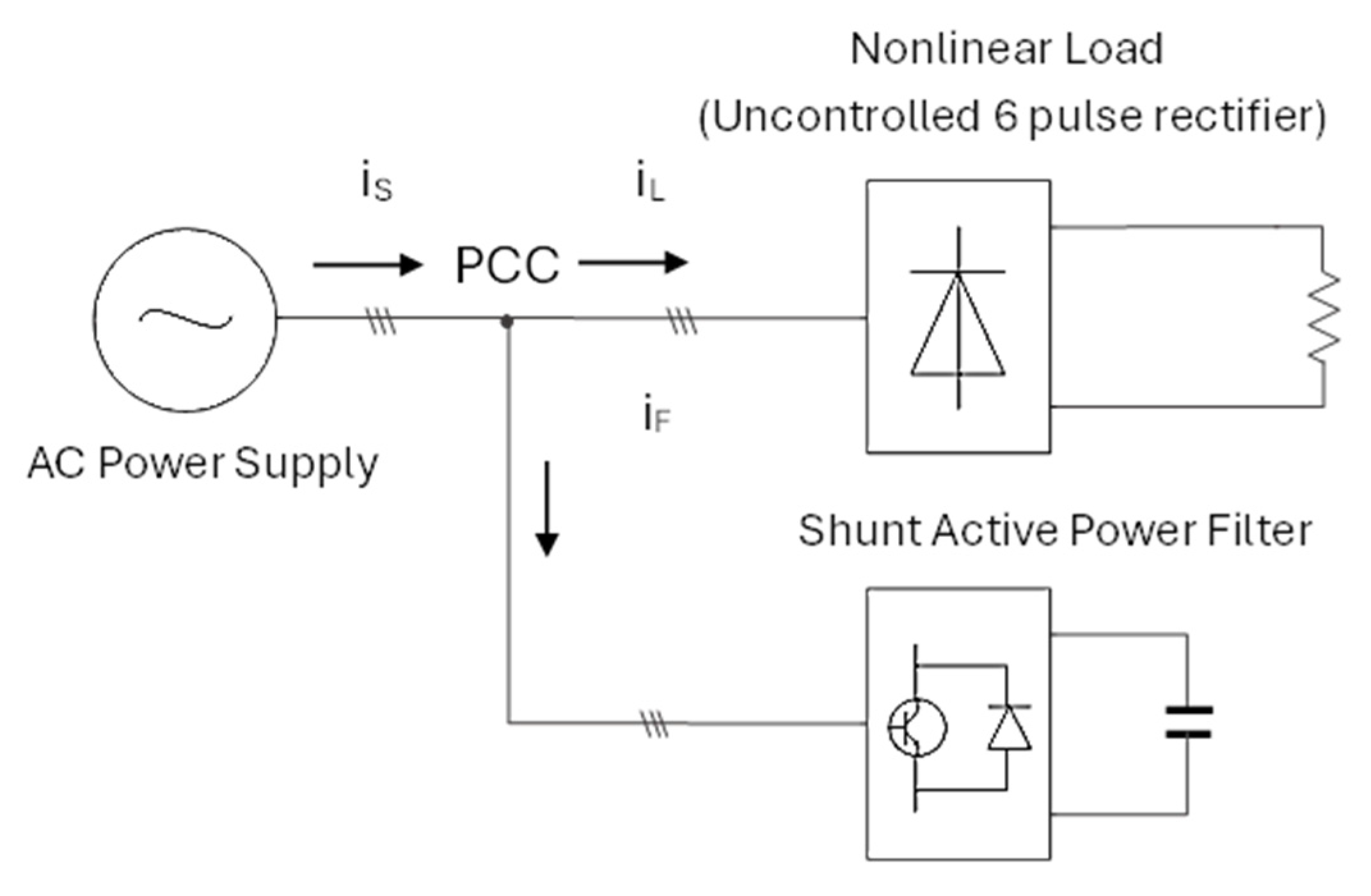
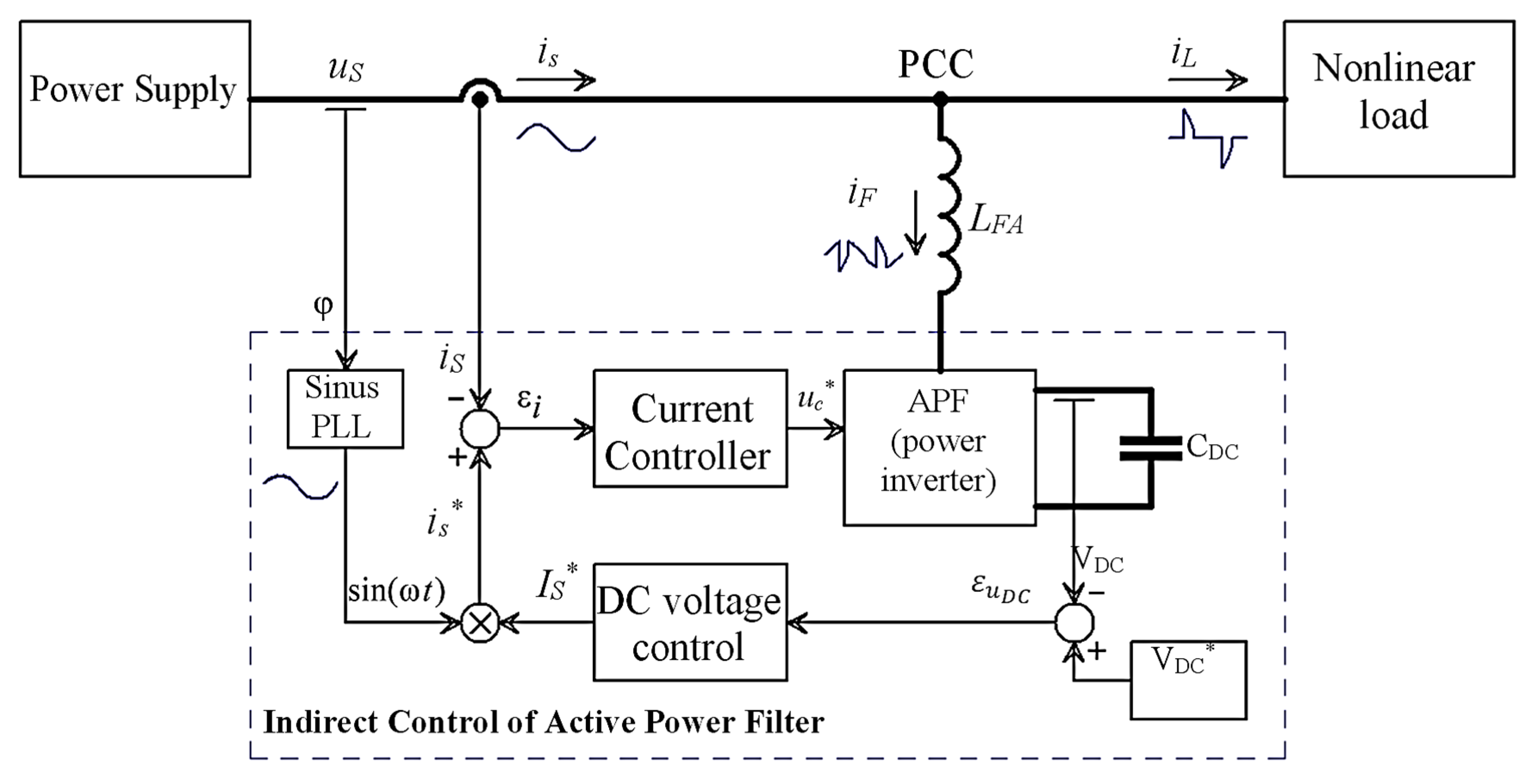
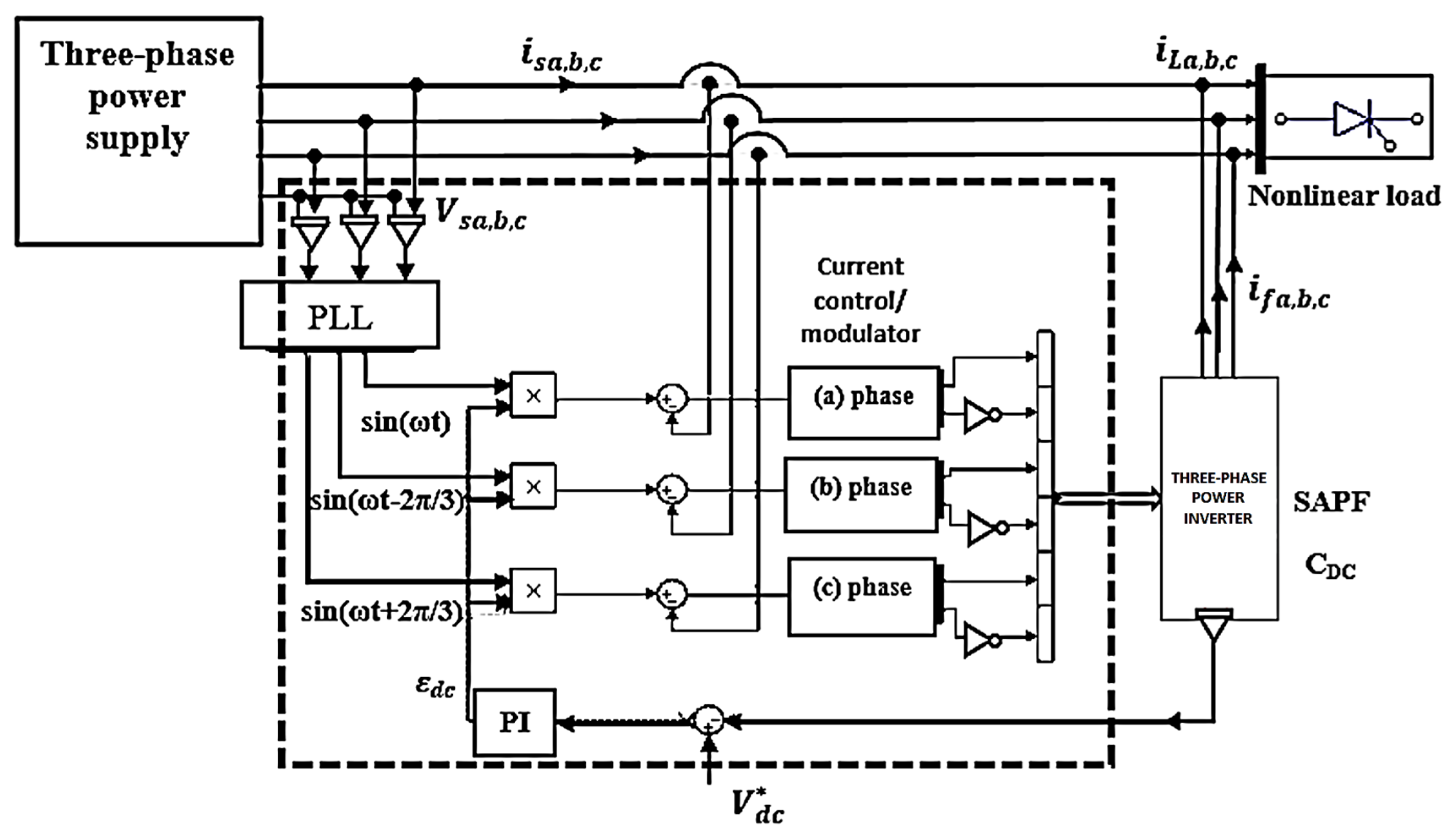

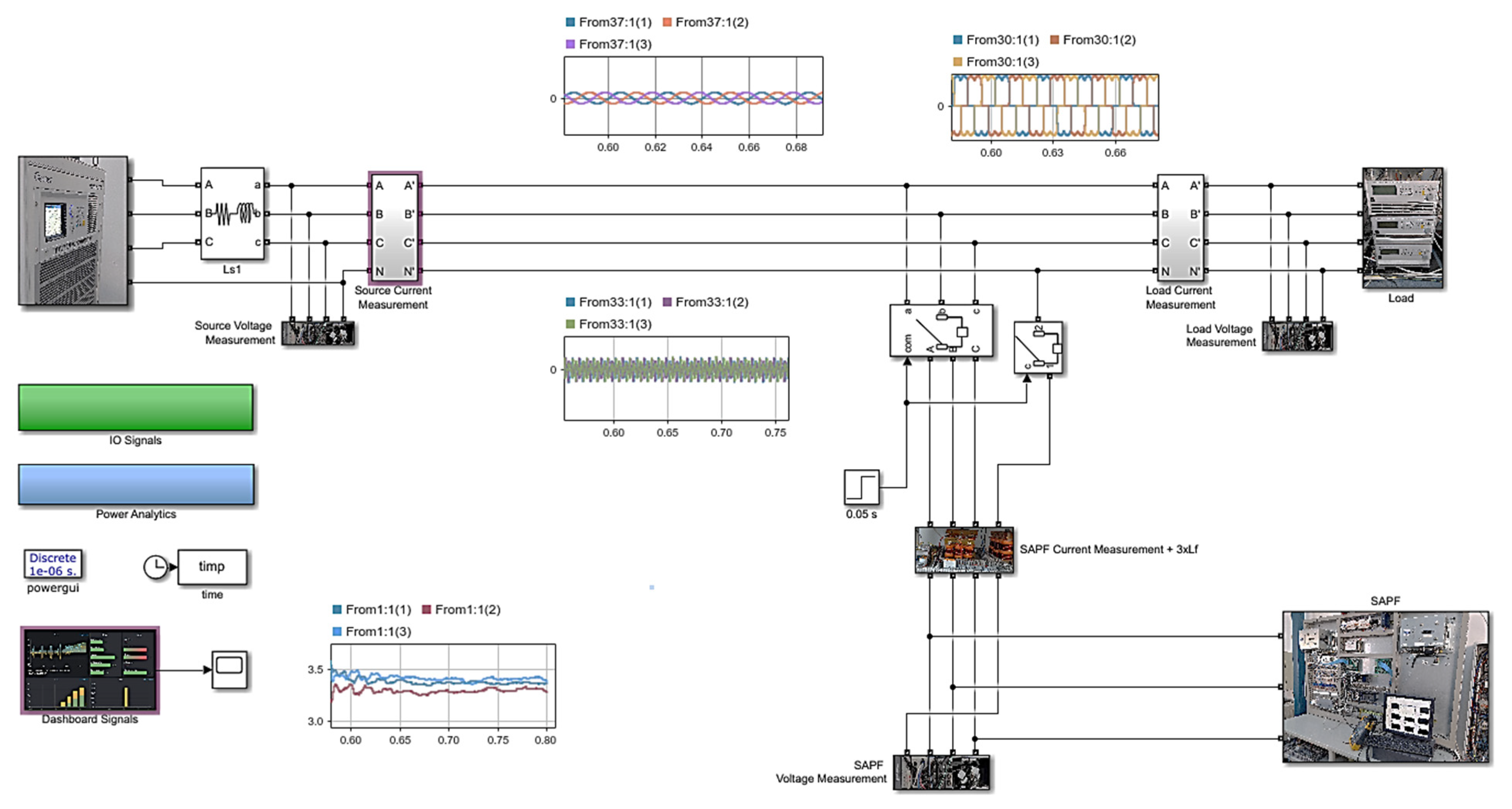


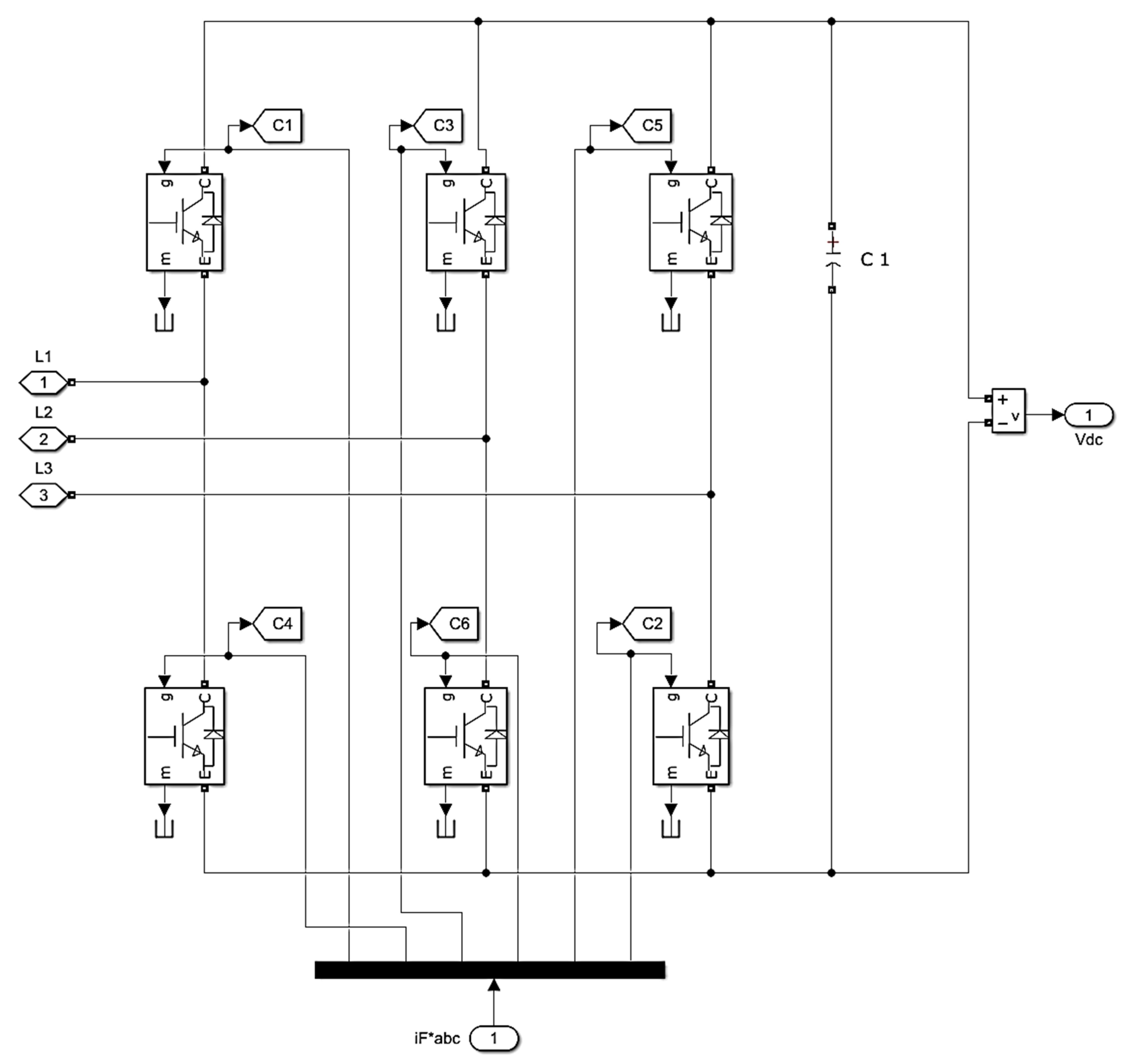
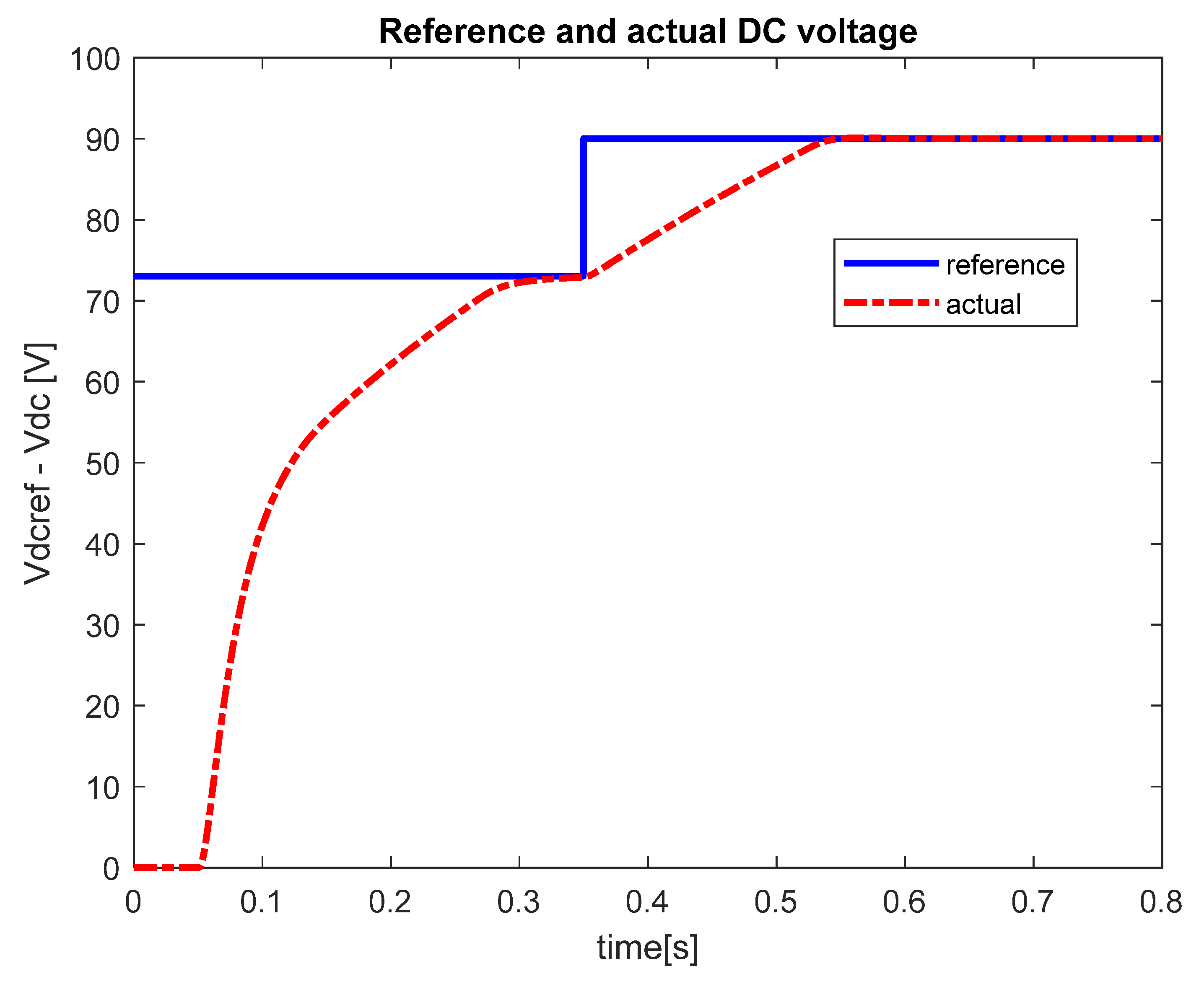

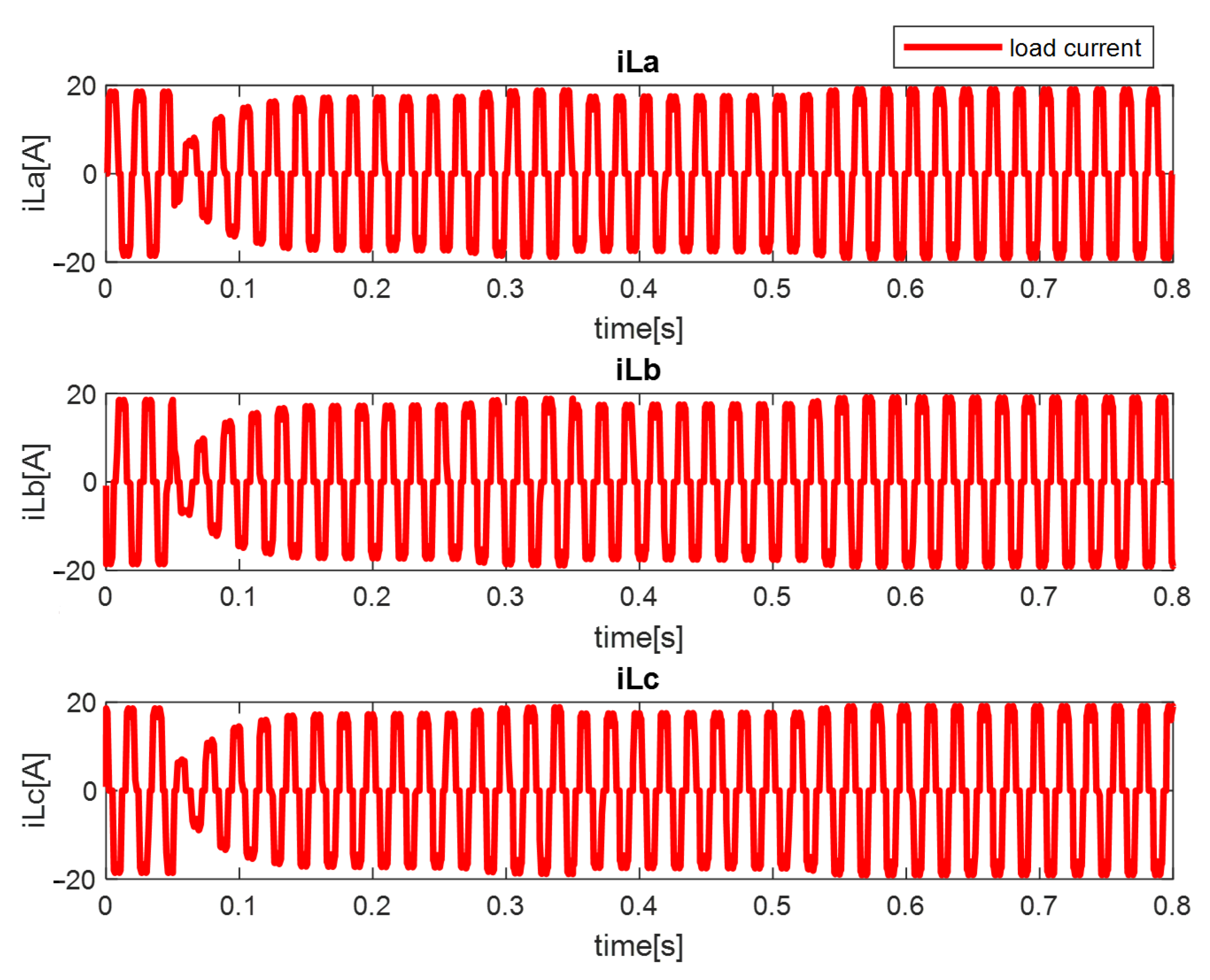


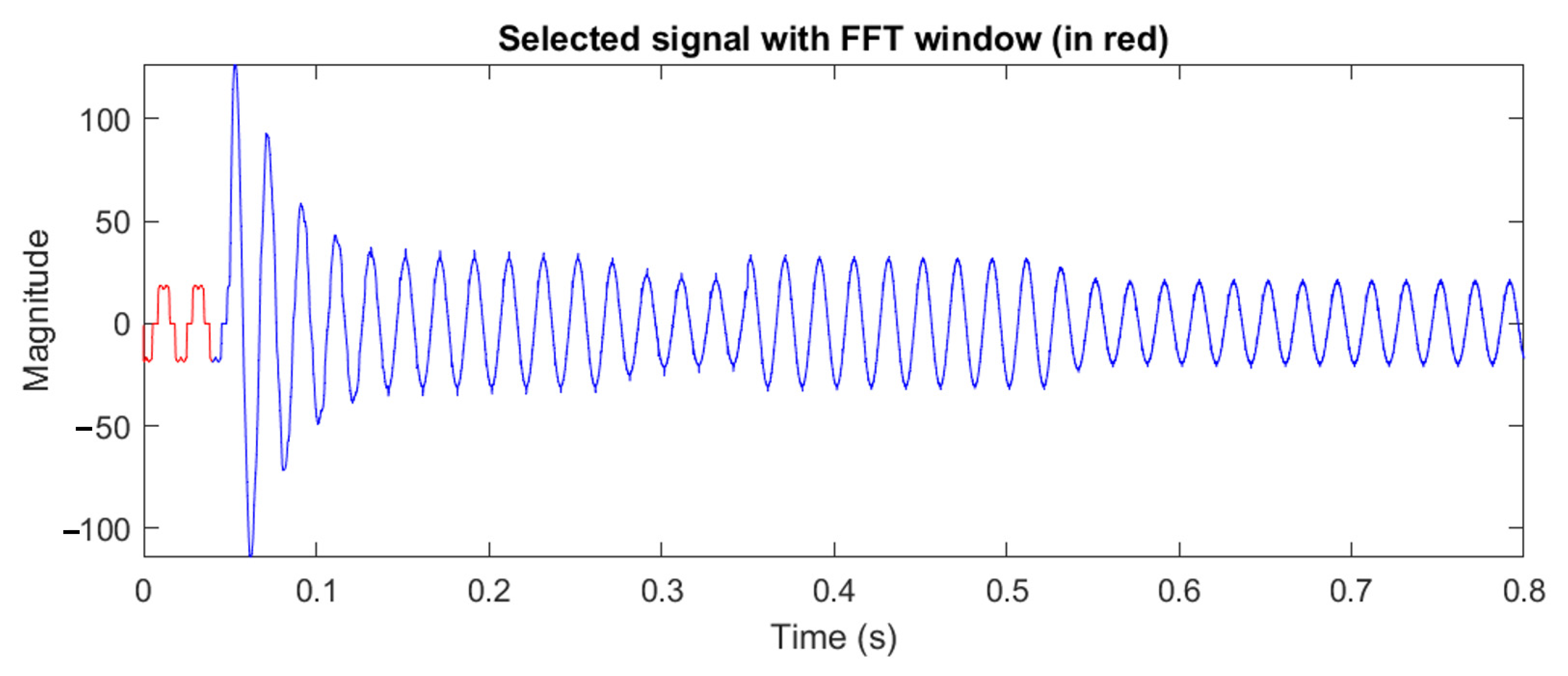

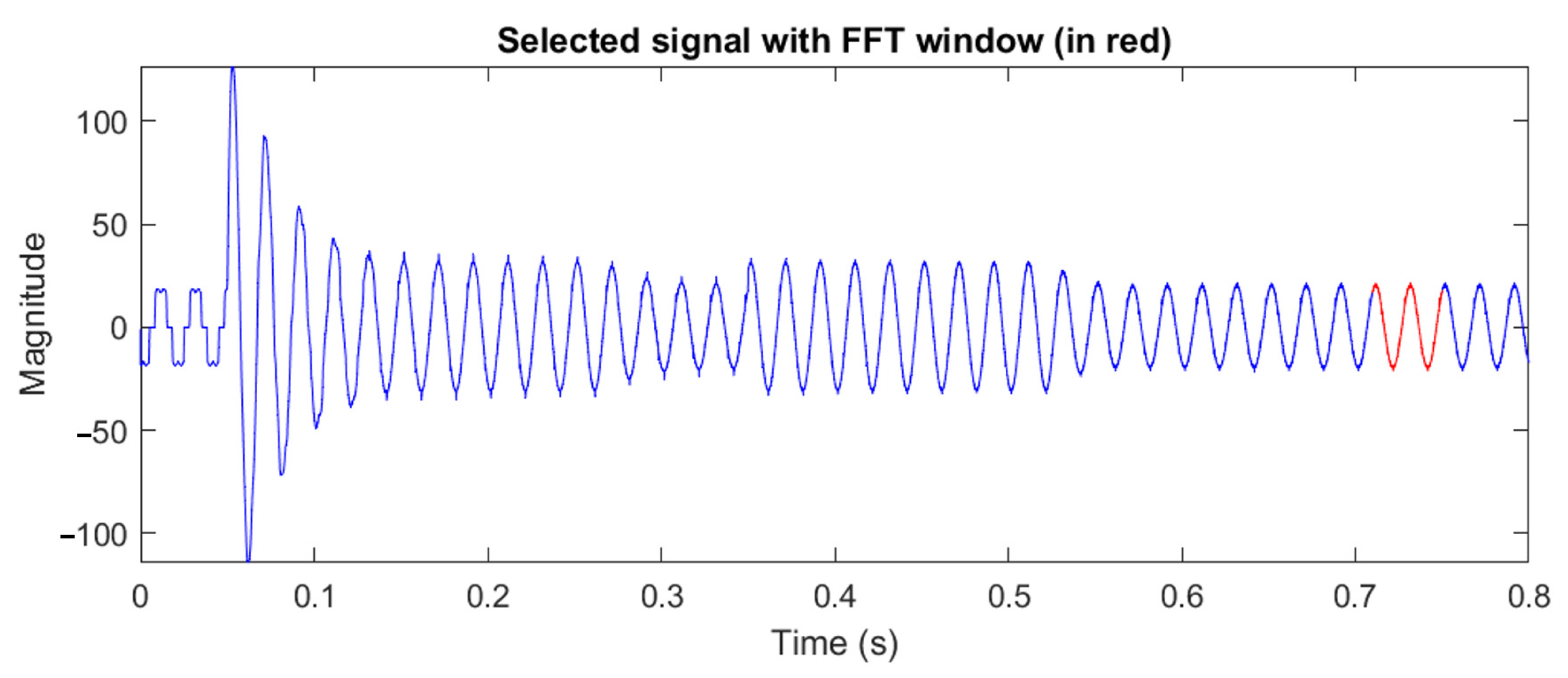
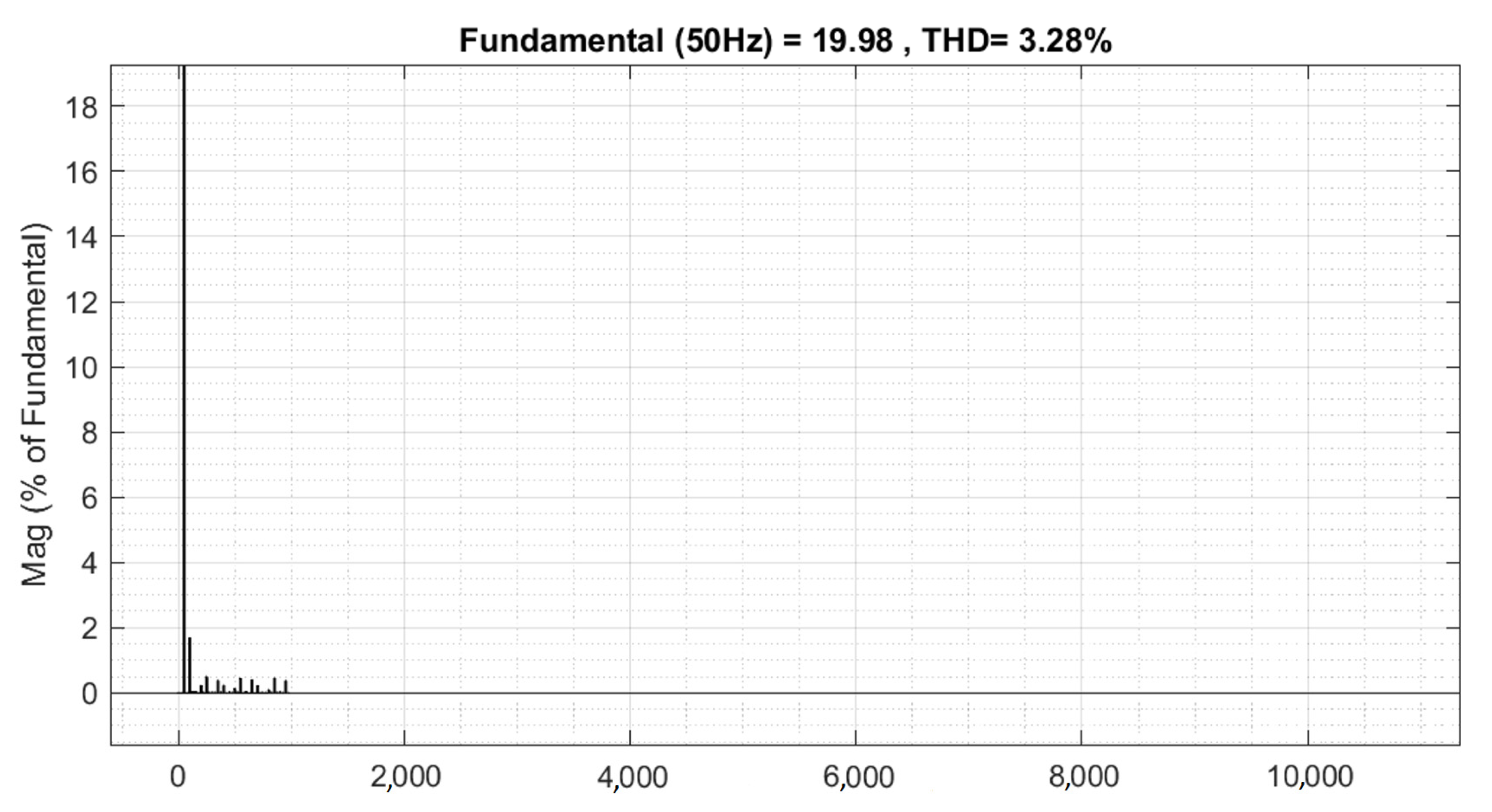
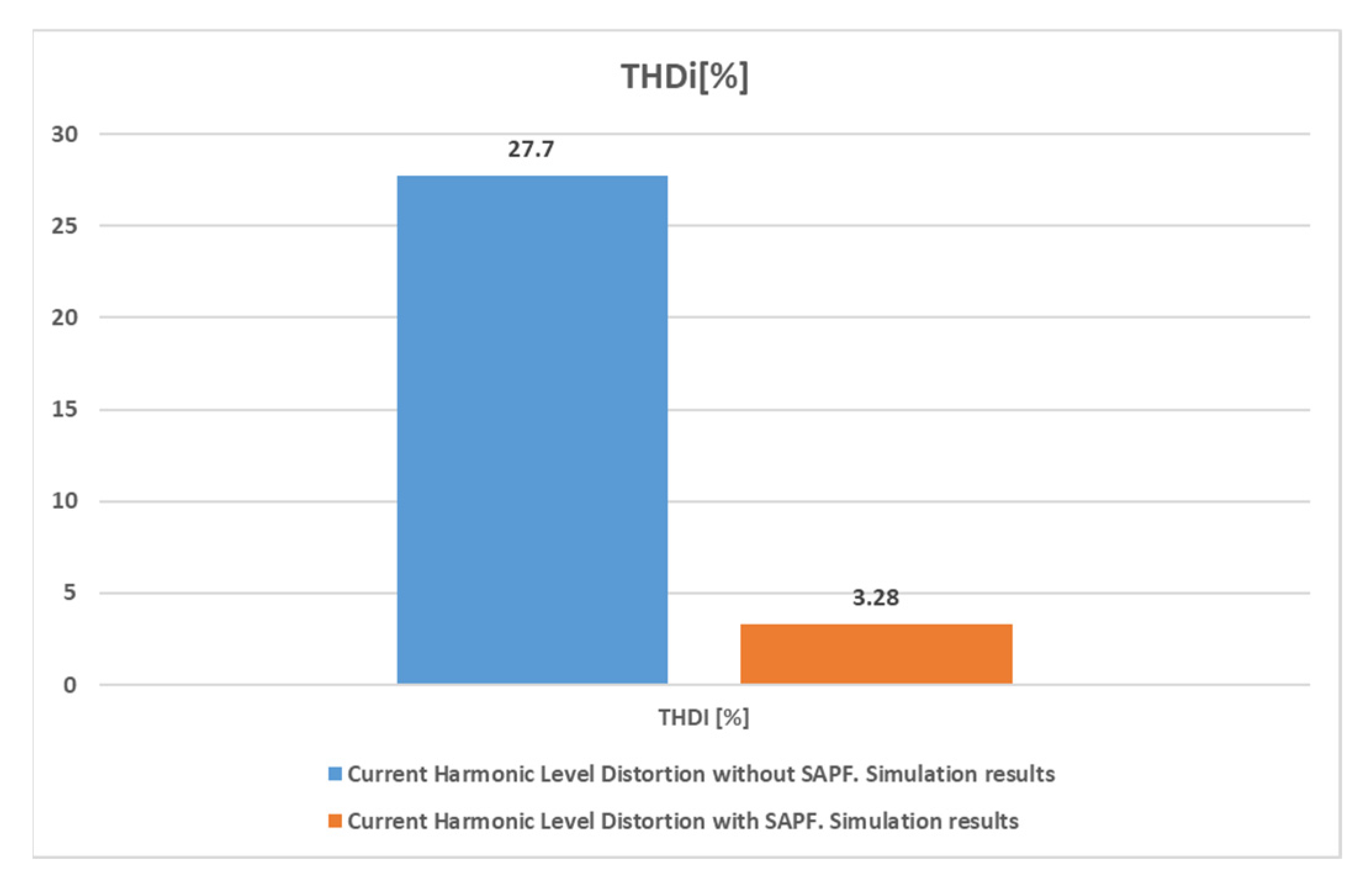

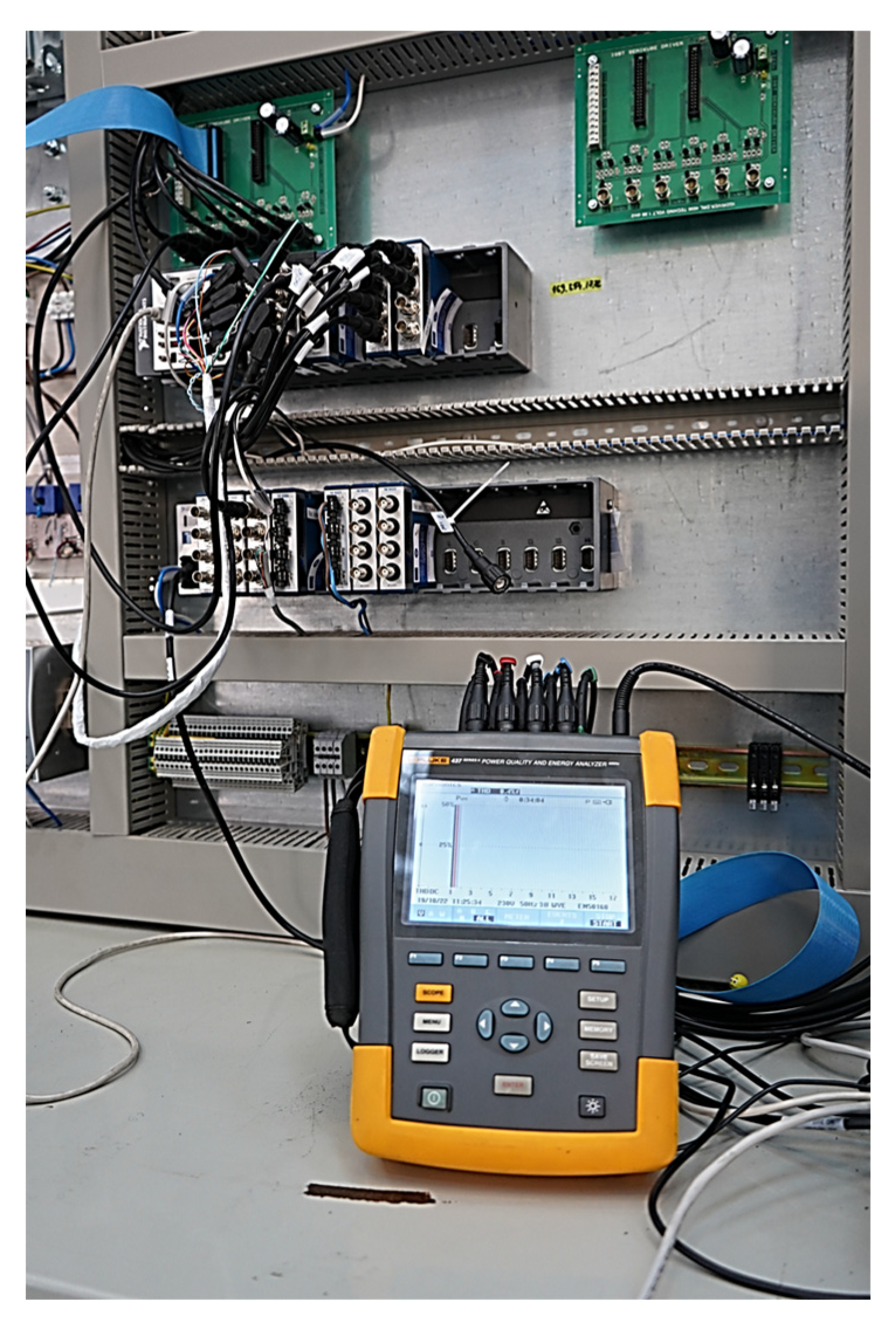

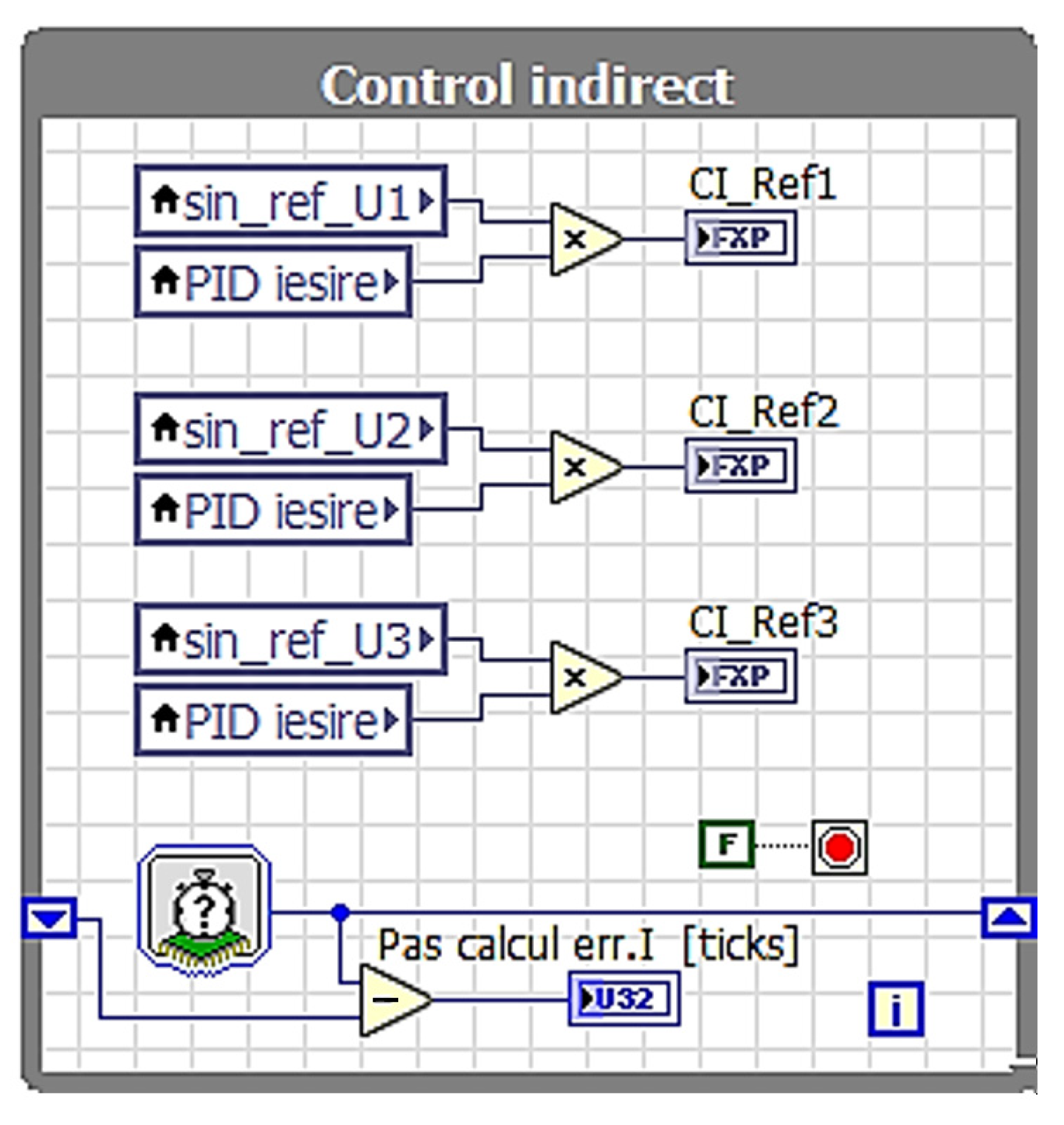



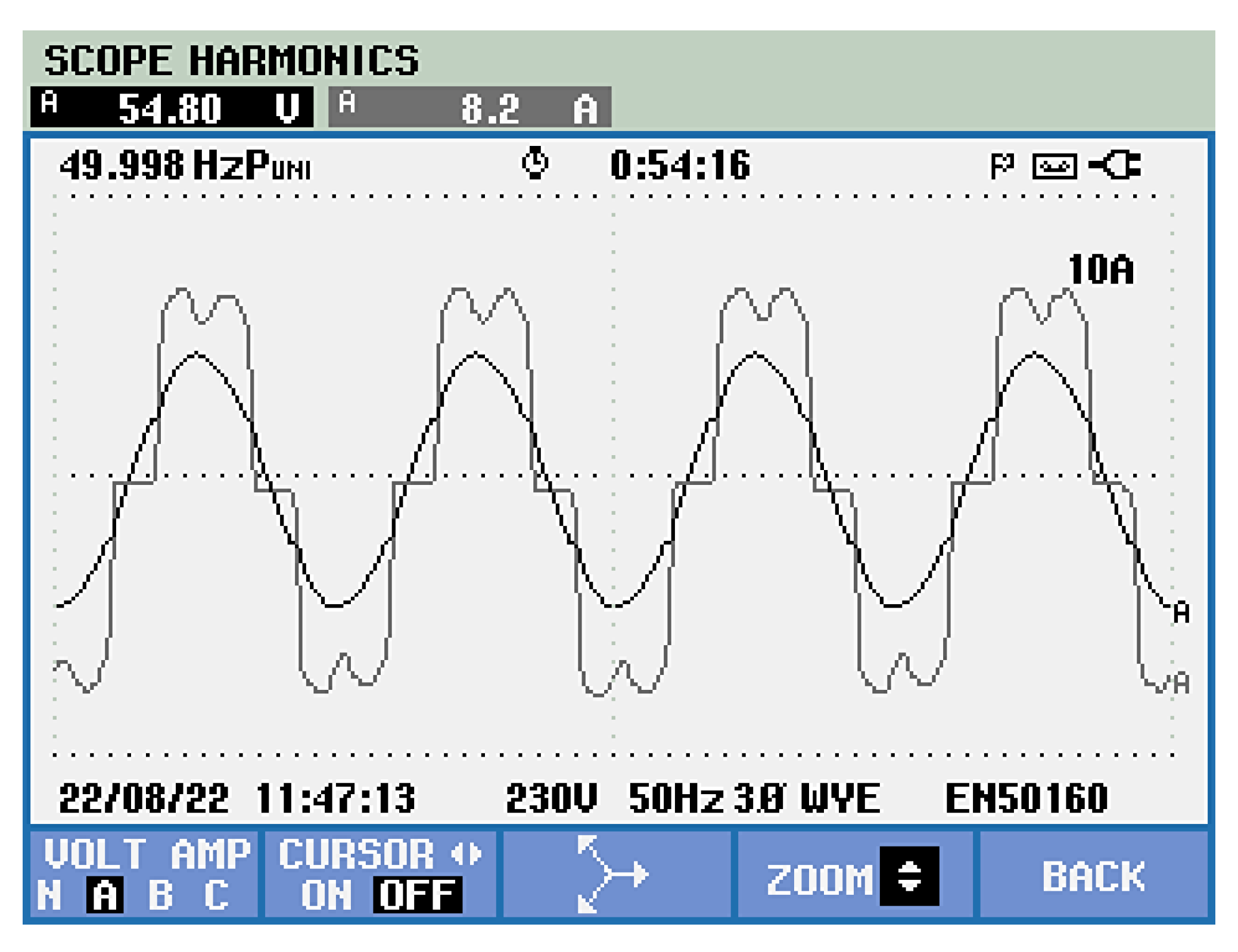
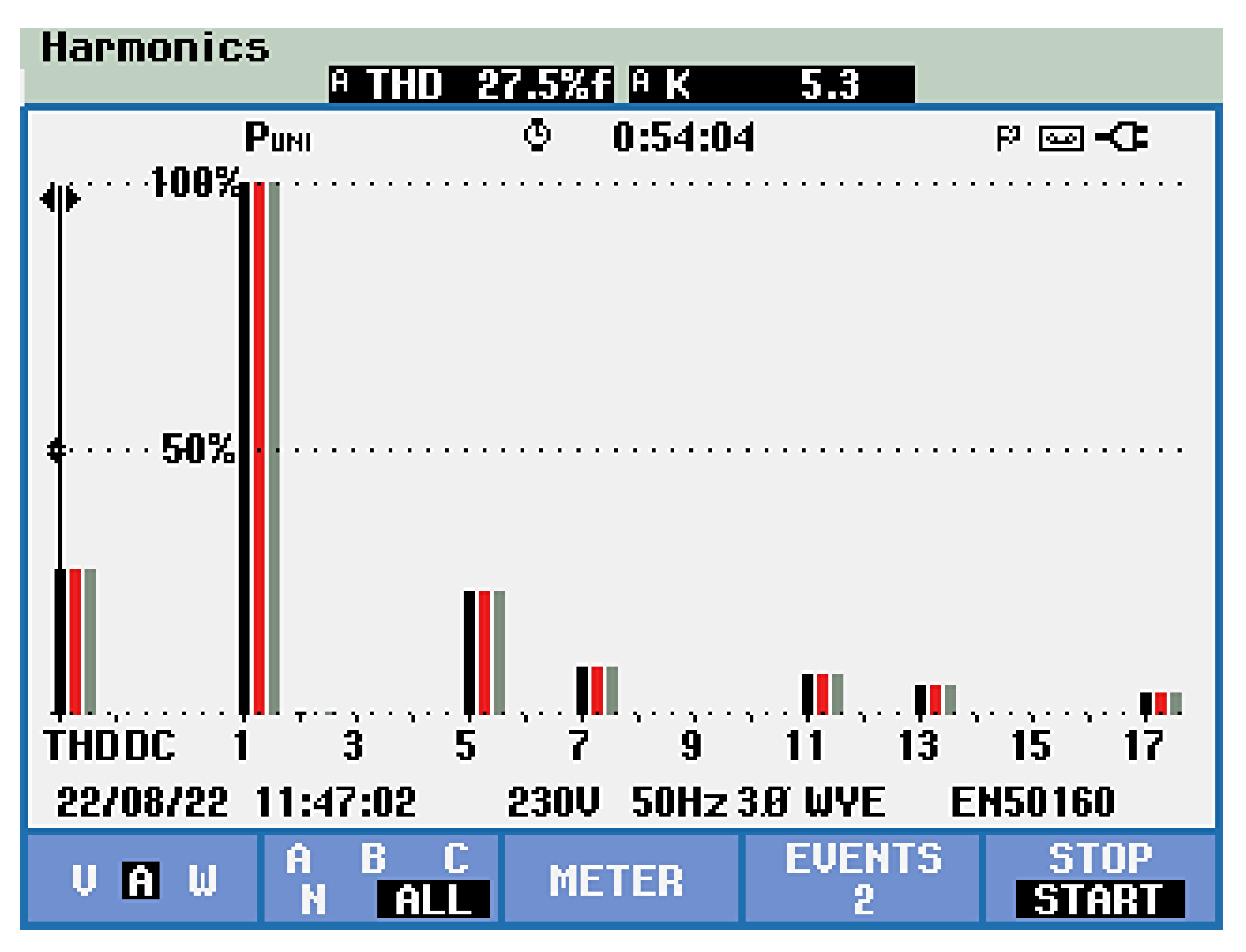
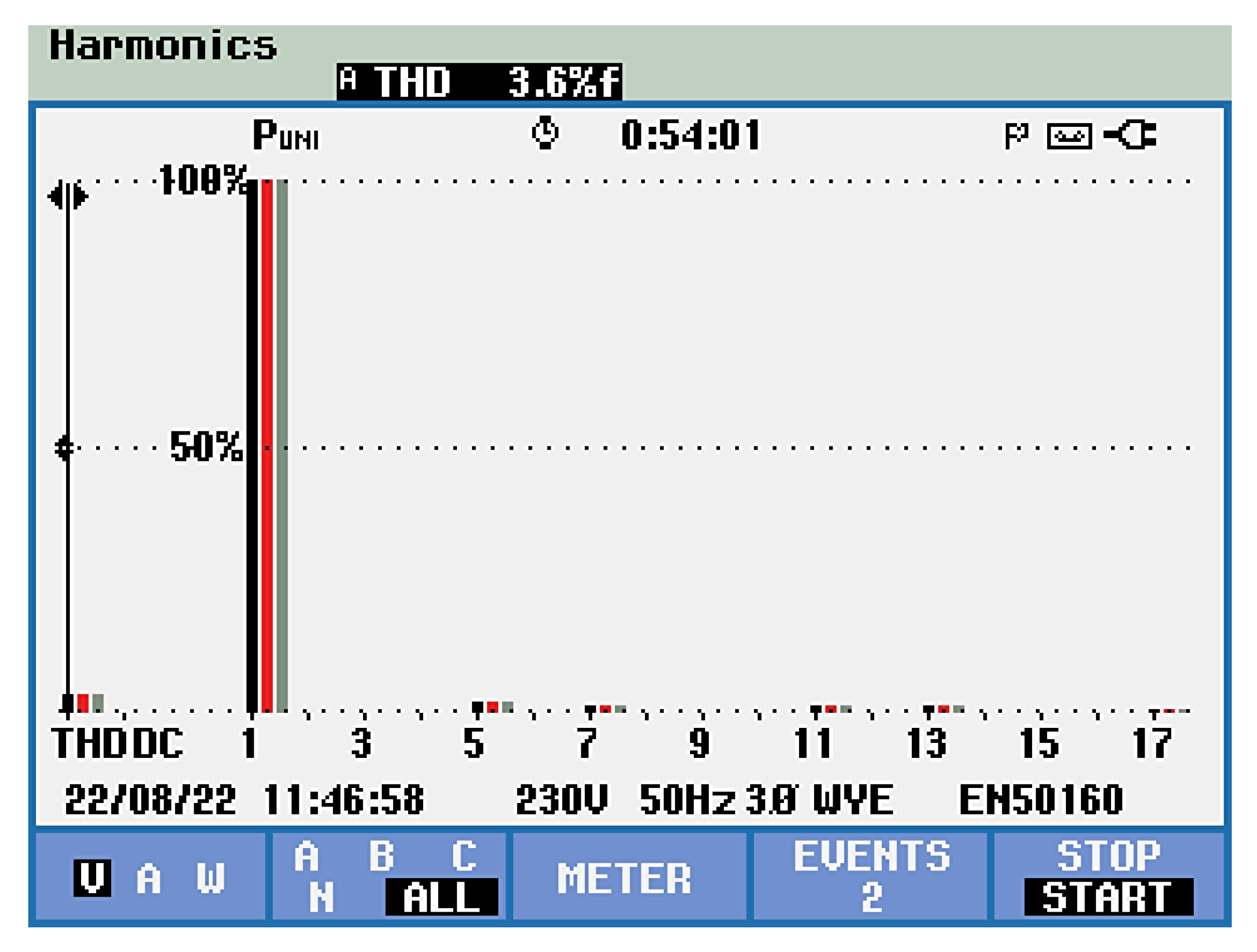


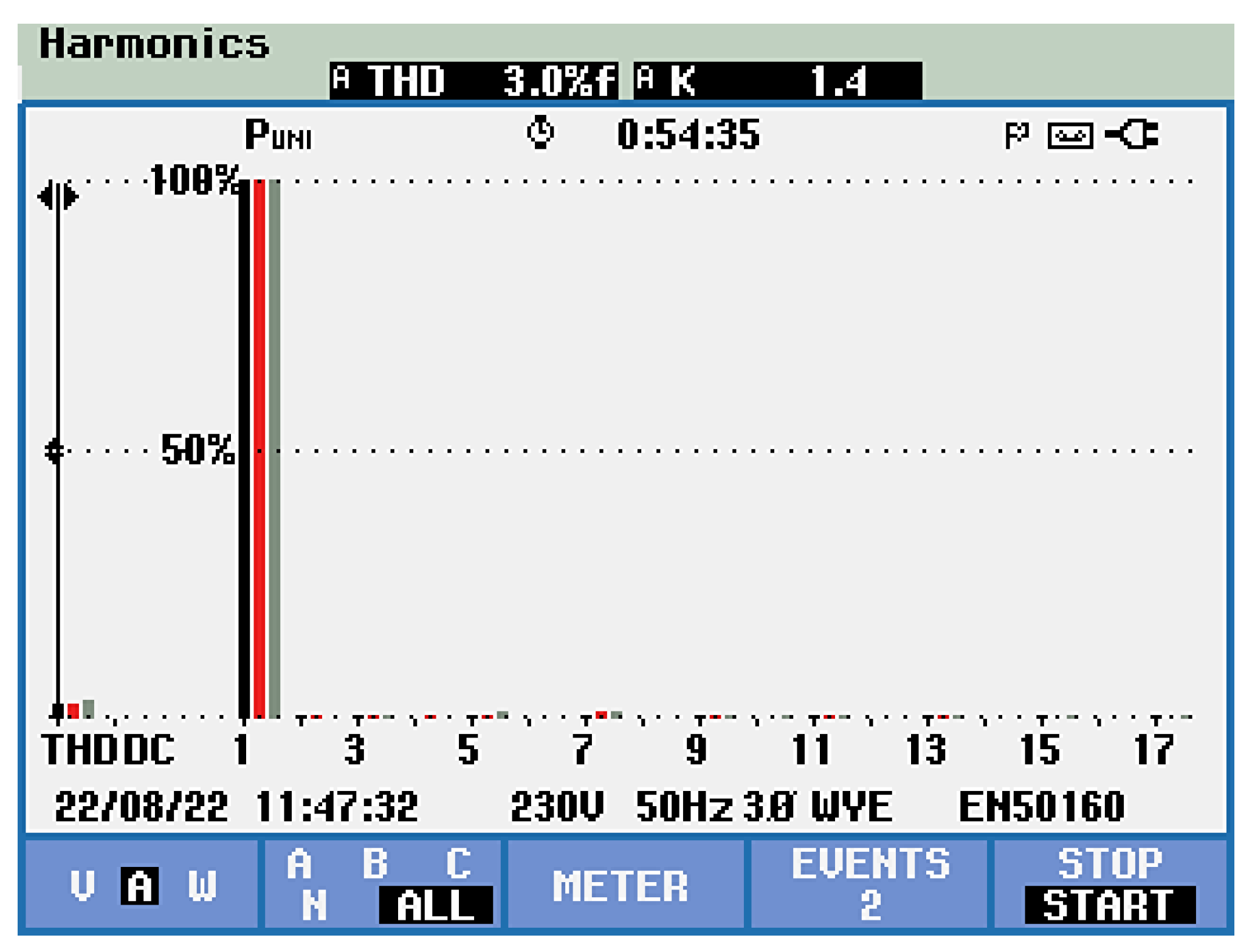
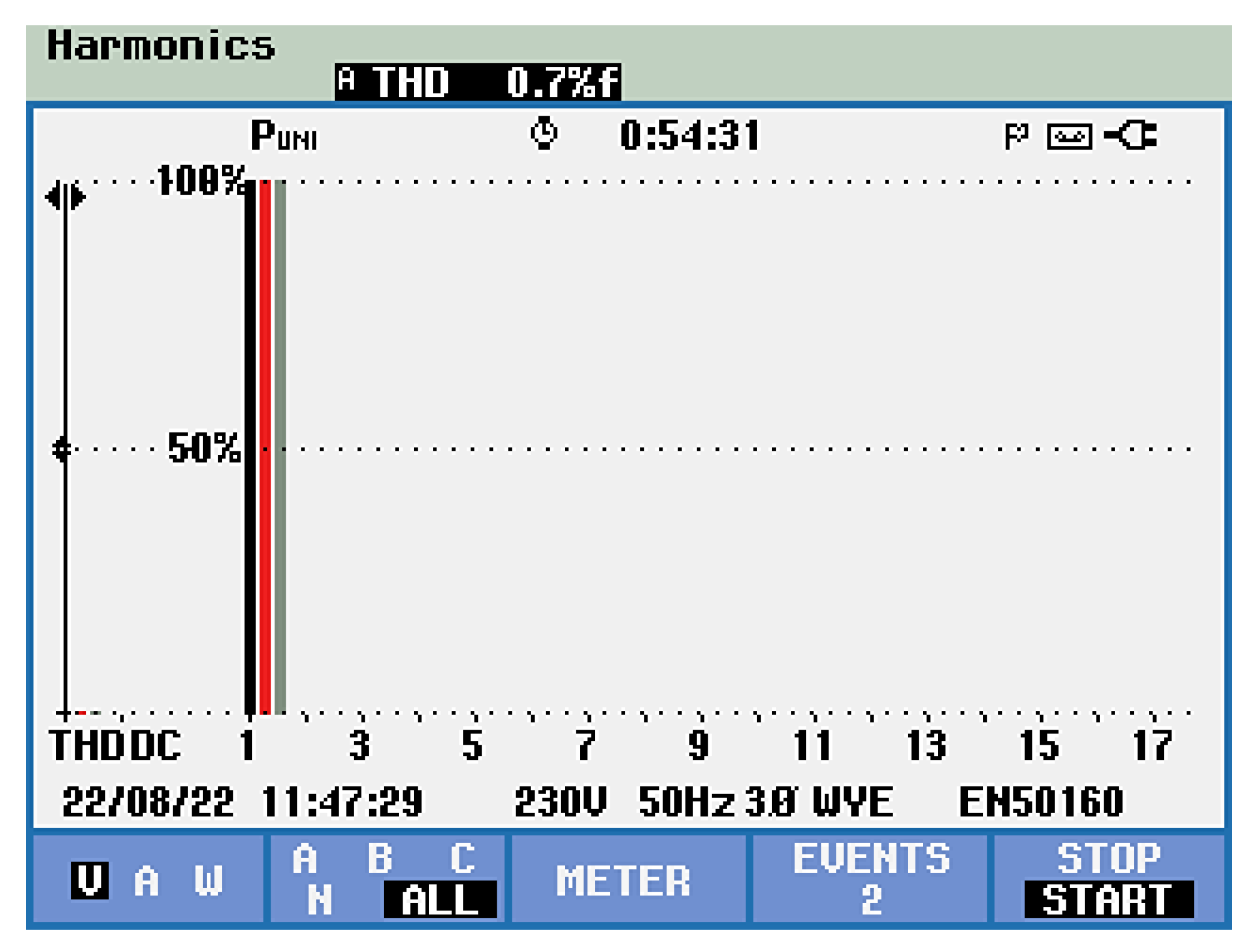
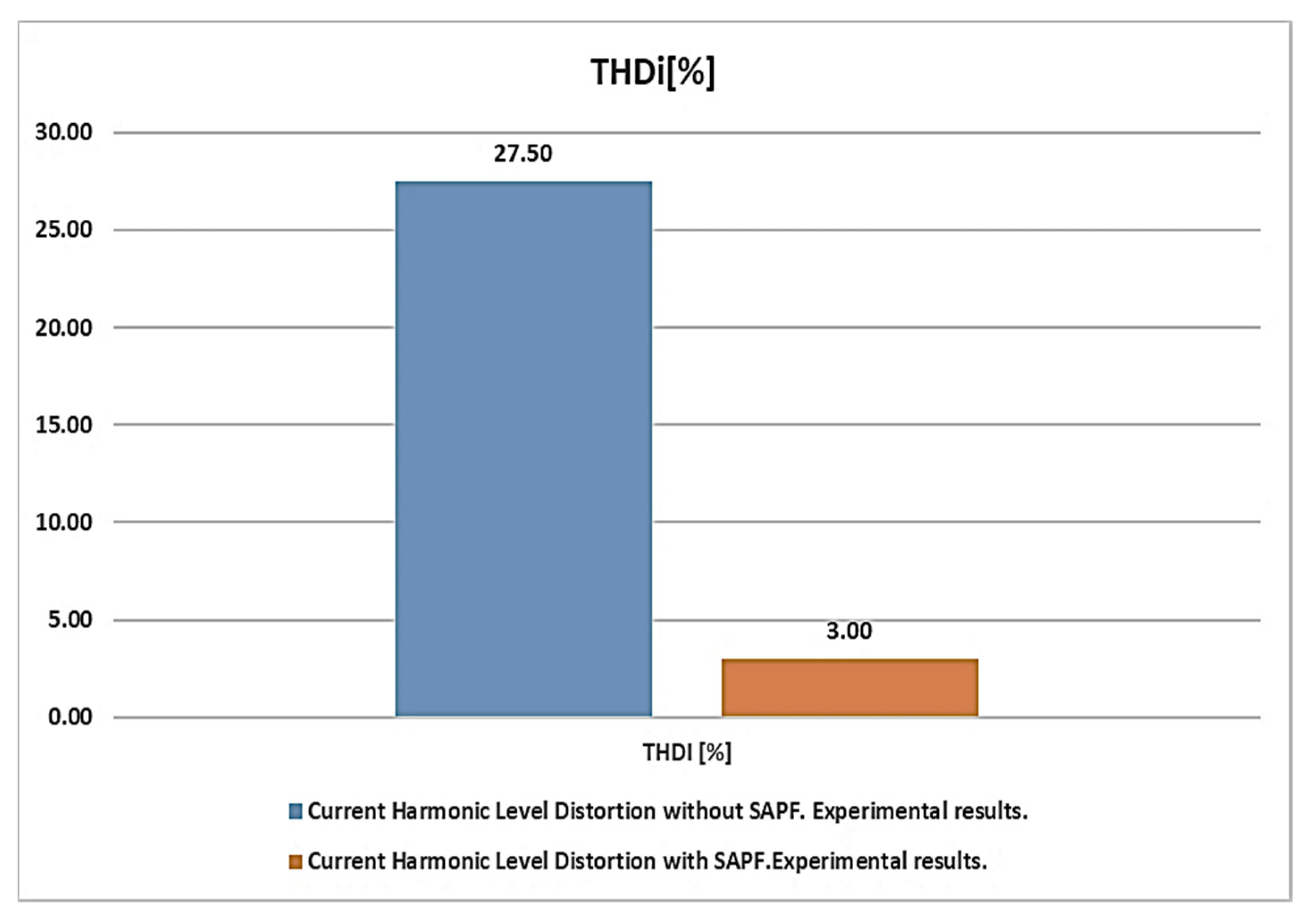



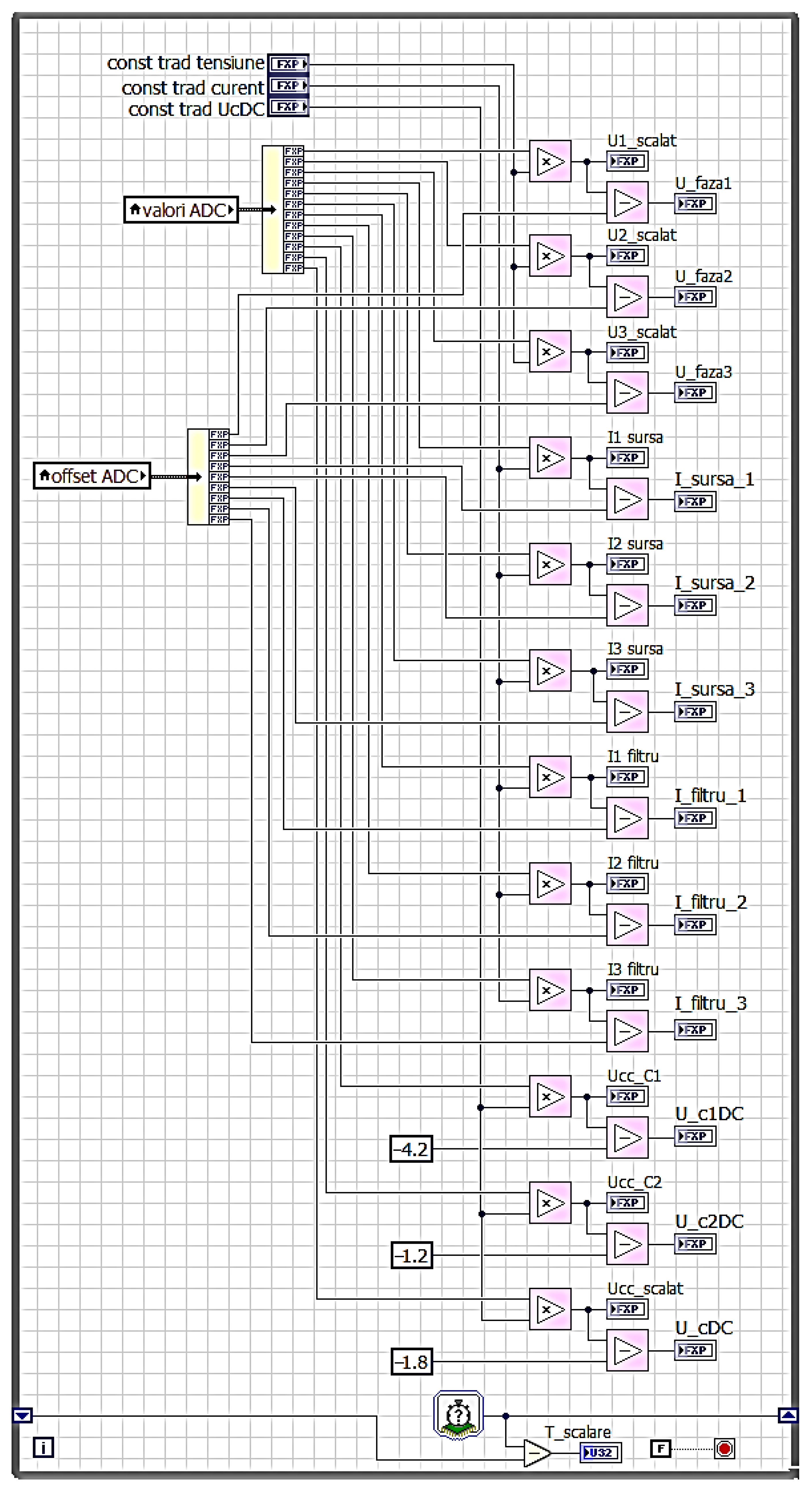
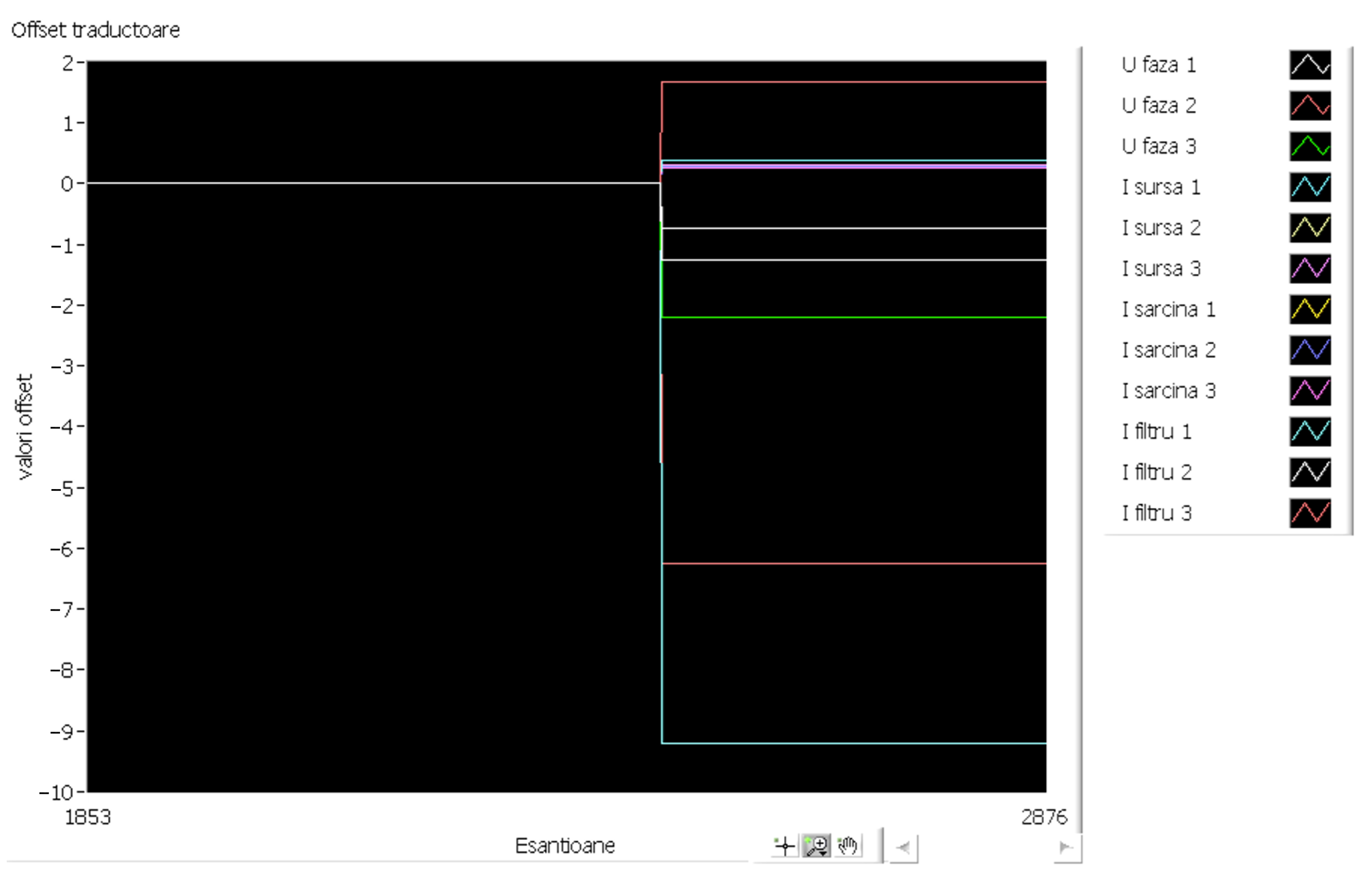
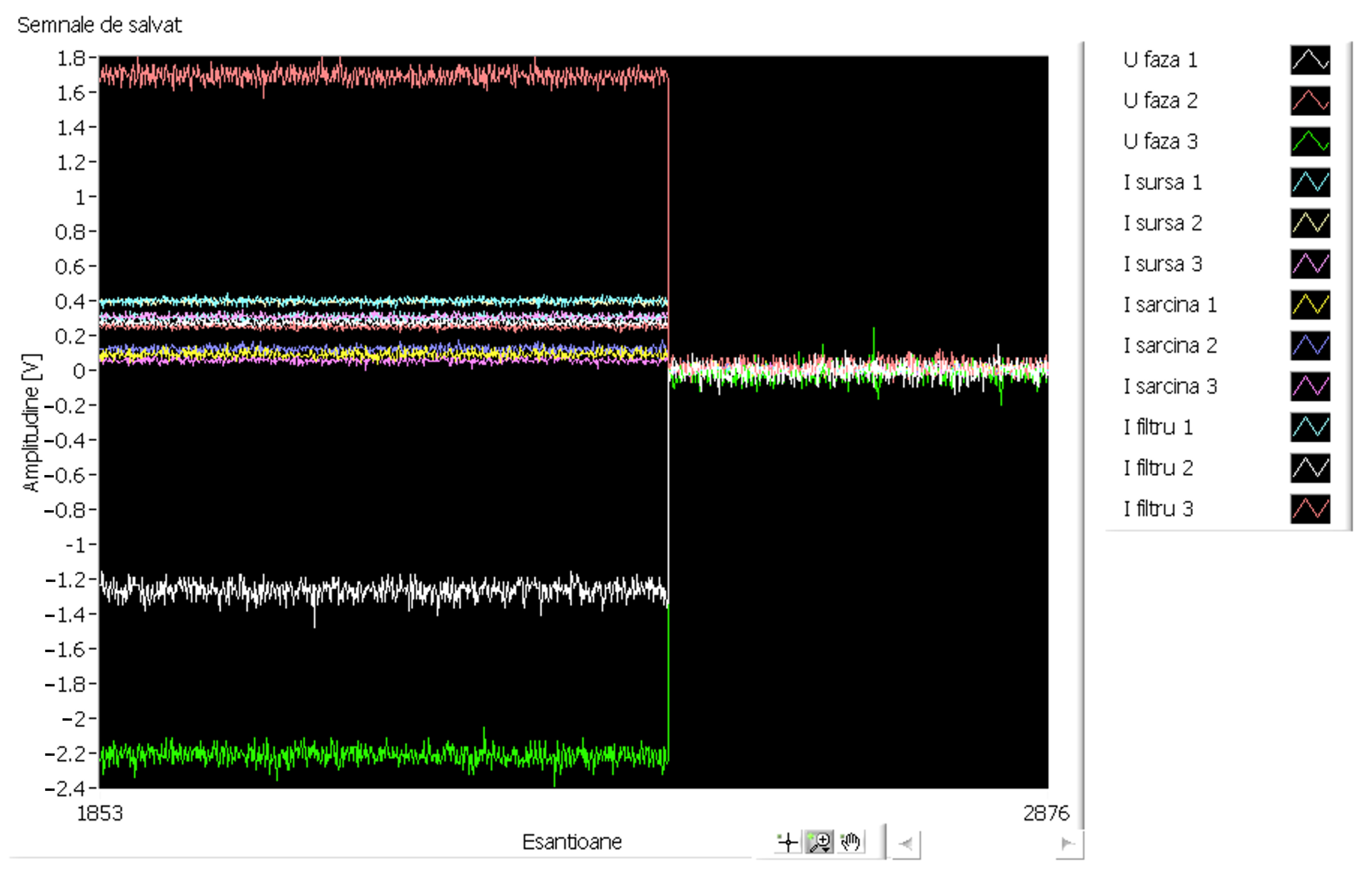
| No. | Control Strategies of the FAP-0L | Abbreviation of the Implemented Configuration | |
|---|---|---|---|
| 1 | Developed on the principle of instantaneous powers (PQ) | FAP-0S | |
| 2 | Developed on the principle of synchronous algorithm (DQ) | FAP-0US | |
| 3 | Developed on the principle of maximum (MAX) | FAP-0IA | |
| 4 | Developed on the principle of indirect control (CI) | FAP-0ET | |
| 5 | Developed on the principle of synchronization of current with the voltage positive sequence component (SEC-POZ) | FAP-0E | |
| 6 | Developed on the method of separating polluting components | Band stop filter—FOB | FAP-0SE |
| 7 | Low pass filter—FTJ | FAP-0D | |
| 8 | Indirect Control | FAP-0L | |
| No active Power Filter Connection | Connected Active Power Filter | |
|---|---|---|
| THDu [%] | 3.6 | 0.7 |
| THDi [%] | 27.5 | 3 |
| Test Bench | Parameter | Numerical Value | SI Units |
|---|---|---|---|
| Power supply | Voltage (Vs) | 58 | V |
| Frequency | 50 | Hz | |
| Nonlinear load | Uncontrolled power bridge with load Resistance (R) | 17 | Ω |
| Harmonic active power filter | Inductance (L) | 0.00192 | H |
| DC link capacitance (C) | 0.0015 | F | |
| Switching frequency (fsw) | 25,000 | Hz | |
| DC link voltage (Vdc) | 90 | V | |
| Voltage controller | Proportional gain (kp) | 2.4 | |
| Integral coefficient (ki) | 22 |
| Control Method | Robust Under Distortion | Handles Unbalance | Fast Dynamic Response | Simplicity (Implementation) | No PLL/Transforms |
|---|---|---|---|---|---|
| Approach [46,47,48,50] | Very robust—handles distorted & polluted voltages | Effective in 3-phase, 4-wire systems | Fast response; no filter delays or PLL lag | Simple—no transforms, no sequence extraction | Works directly in time domain |
| pq Theory [46,50] | Poor under distorted voltages | Not suitable for unbalanced systems | Fast but inaccurate under non-ideal conditions | Requires only Clarke transform | No PLL required |
| SRF Theory [46,48,50] | PLL vulnerable to distortion | Limited—requires positive-sequence filtering | Slow due to LPF & PLL | Needs PLL, Park transform | PLL mandatory |
| Max Method [47] | Assumes ideal voltage waveform | Not suitable for unbalance | Moderate speed, poor accuracy under distortion | Simple algorithm | No PLL or transform required |
| Positive Sequence Sync. [46,50] | Robust via sequence isolation | Can isolate positive sequence | Slow due to sequence computation | Complex: sequence extraction + filtering | Requires transforms & PLL |
| Band-Stop Filter [49,50] | Harmonic drift and delay issues | Works if tuned properly | Slow due to filtering delay | Complex if many harmonics must be rejected | No PLL or transform needed |
| Low-Pass Filter [47,48] | Fundamental leakage under distortion | Acceptable for moderate unbalance | LPF delays; trade-off between speed and accuracy | Easy to implement filtering | No PLL required |
| Feature | Indirect Approach | Other Modern Methods |
|---|---|---|
| Voltage Distortion Robustness [46,50] | Works reliably with distorted or polluted mains voltages | Most methods (e.g., SRF, pq) degrade significantly under voltage distortion |
| Unbalanced Load Handling [46,50] | Handles unbalanced 3-phase, 4-wire systems natively | SRF and pq require positive sequence extraction or extra transformations |
| No PLL Dependency [47,50] | Fully PLL-free, eliminating instability risks | SRF, Positive Sequence Sync, DPC all require PLLs which suffer under harmonics and transients |
| No Reference Filtering Needed [47,48,50] | Analytical ideal reference, no low-pass filters | SRF and LPF methods require filter tuning, causing delay and performance degradation |
| Computation Efficiency [48] | Lightweight; no Park/Clarke, no frequency-domain transformations | Predictive Control, DPC, Model Predictive Control (MPC) are computationally heavy |
| Fast Dynamic Response [48] | Extremely fast due to direct time-domain tracking | Most filtering-based and SRF methods introduce phase delay |
| Harmonic Compensation Coverage [49] | Inherently broadband—compensates any order without tuning | Notch/Band-Stop and Resonant methods must be tuned per harmonic order |
| Ease of Implementation [50] | Ideal for real-time DSP/FPGA-based control systems | Predictive and observer-based methods can be difficult to tune in real-time applications |
| Reference Signal Quality [46,50] | Ideal current reference defined based on power goal (e.g., unity PF, sinusoidal) | LPF-based methods suffer from fundamental leakage or reference distortion |
| Stability and Robustness [47,50] | Strong performance even under load transients and non-ideal grids | Many advanced methods need careful tuning or adaptive control schemes to ensure stability |
| Advantage | Description |
|---|---|
| Simplicity & Predictability | Indirect control has well-understood dynamics, no black-box components. In contrast, ML/neural or hybrid methods often introduce complexity, potentially less predictable behaviour under unseen conditions. This makes verification, reliability, and certification easier for indirect methods. |
| Lower Computational & Implementation Burden | Indirect control uses analytical reference generation, simpler control loops. Future methods tend to require more CPU/MEM resources, heavier sampling, training, and optimization. In resource-constrained environments (low-cost DSPs, FPGA, embedded controllers), indirect control is more feasible. |
| Robustness under Uncertainty/ Disturbances without Heavy Training Data | ML/NN/neuro-fuzzy often need large datasets, retraining, are sensitive to data quality. Indirect control, being analytic/model-based, handles distortions, voltage unbalance, nonlinear loads with fewer data requirements, more predictable performance under disturbances. |
| Fast Transient Performance | Because indirect control does not rely on filtering/harmonic extraction or long prediction horizons (as in MPC), it has inherently low latency. New methods may suffer delays (e.g., predictive control or neural network calculation times) especially under high switching frequencies or many harmonics. |
| Ease of Tuning & Maintenance | Indirect control parameters are fewer and well understood. New methods often have many hyperparameters (network architecture, prediction horizon, etc.), which complicate tuning, stability analysis, and maintenance. |
| Reliability & Interpretability | For critical power quality systems, deterministic, interpretable behaviour matters. Indirect control has clearer behaviour; whereas learning-based methods may be “black boxes,” with potential risk under unseen operating conditions. |
| Scalability/Real-Time Constraints | In systems with many APFs, distributed installations, or very tight real-time constraints, indirect control scales well ML/MPC may scale poorly or require high sampling rates, high computational power. |
| Method | How It Works | Strengths | Weaknesses | Compared to Indirect Approach |
|---|---|---|---|---|
| 1. Principle of Instantaneous Powers (pq theory) | Uses Clarke transform to get α-β coordinates; computes instantaneous active/reactive power | Real-time, widely used, simple in 3-phase 3-wire systems | Sensitive to unbalance and distortions; complex in 3-phase 4-wire; requires voltage measurement accuracy | Indirect approach is more robust to distortion and works better under unbalanced conditions |
| 2. Synchronous Algorithm (SRF theory) | Uses Park transform to extract d-q components; filters out harmonics in d-q frame | Good selectivity, tracks fundamental | Needs PLL; slow in dynamic response; complexity in implementation | Indirect approach avoids PLL errors and has better transient response |
| 3. MAX Method | Detect maximum current or voltage and reconstructs reference | Simple hardware implementation | Not selective; poor harmonic detection | Indirect approach is more selective, handles variable loads better |
| 4. Synchronization with Voltage Positive Sequence | Syncs current to positive sequence of voltage (e.g., IEEE 1459 approach) | Effective under distortion | Requires voltage decomposition; high computational load | Indirect method bypasses voltage sequence separation and is simpler for real-time |
| 5. Band Stop Filter for Harmonic Extraction | Filters out certain harmonics directly from current | High selectivity for known frequencies | Poor transient response; introduces delay; cannot track unknown frequencies | Indirect approach does not rely on specific harmonic knowledge, more adaptive |
| 6. Low Pass Filter for Fundamental Extraction | Filters fundamental current from load | Simple, smooth waveform | Delay in dynamic loads; leakage of harmonics; fundamental not always pure | Indirect method is faster and more accurate in non-stationary loads |
| Method | Shortcoming Addressed | Typical THD Achieved |
|---|---|---|
| Instantaneous Power Theory (p–q) [55,56,57,58] | Works in time-domain; handles dynamic loads | 5–7% |
| Synchronous Reference Frame (SRF, dq0) [59,60,61,62] | Separates DC (fundamental) and AC (harmonics) | 4–6% |
| MAX Method [55,57,58] | Simple, but less accurate under distortion | 8–12% |
| Synchronization with Positive Sequence [57,61,63] | Handles voltage imbalance/distortion | 4–6% |
| Band Stop Filter (BSF) [64,65] | Selective harmonic removal | 6–10% |
| Low Pass Filter (LPF) [66,67] | Extracts fundamental; introduces phase delay | 5–7% |
| Indirect Control [68] | Robustness and noise immunity | 4–7% |
| Feature | Indirect Approach | Other Modern Methods |
|---|---|---|
| Voltage Distortion Robustness | Works reliably with distorted or polluted mains voltages | Most methods (e.g., SRF, pq) degrade significantly under voltage distortion |
| 1. Adaptive & Data-Driven Control Architectures [67,70] | Online adaptive controllers (e.g., MRAC, neural networks) combined with MPC for better performance under varying load/grid conditions | Non-stationary load compensation, improved reference current estimation, adaptive tuning |
| 2. Predictive Control with Delay Compensation [71,72] | Advanced predictive control methods that explicitly model sensor and actuator delays | Compensation accuracy under dynamic load changes, robustness to implementation delays |
| 3. Improved Synchronization & Robust PLLs [63,73] | PLL and synchronization algorithms robust to weak grids, voltage distortion, and unbalance | Accurate phase detection in weak/distorted grids, stable SAPF operation |
| 4. Selective Harmonic Suppression & Resonance Damping [69,73] | Targeted harmonic suppression using RDFT and adaptive damping to avoid filter resonance | Efficient harmonic compensation, resonance mitigation in LCL filters |
| 5. Combination of Multiple Filtering/Estimation Techniques [74,75] | Hybrid filters combining band-stop, low-pass, and adaptive filters for better harmonic separation | Improved pollutant harmonic extraction, adaptive filtering |
| 6. Hardware/Practical Implementation Constraints [67,71] | Minimizing switching losses, dealing with inverter nonidealities, sensor noise, and real hardware constraints | Reduction of switching losses, noise robustness, practical feasibility |
| 7. Weak Grid Conditions/Islanded Grids [70,71] | Robust control techniques to handle fluctuating voltage, source impedance in islanded or weak grid scenarios | Stability and performance under weak and autonomous grids |
| 8. Reducing Computational Burden & Real-Time Feasibility [67,70] | Algorithmic optimization for fast computation, lower hardware cost, suitable for real-time operation | Efficient computation, cost-effective hardware deployment |
Disclaimer/Publisher’s Note: The statements, opinions and data contained in all publications are solely those of the individual author(s) and contributor(s) and not of MDPI and/or the editor(s). MDPI and/or the editor(s) disclaim responsibility for any injury to people or property resulting from any ideas, methods, instructions or products referred to in the content. |
© 2025 by the authors. Licensee MDPI, Basel, Switzerland. This article is an open access article distributed under the terms and conditions of the Creative Commons Attribution (CC BY) license (https://creativecommons.org/licenses/by/4.0/).
Share and Cite
Gaiceanu, M.; Epure, S.; Solea, R.C.; Buhosu, R.; Vlad, C. Low-Voltage Test Bench Experimental System for Current Harmonics Mitigation. Energies 2025, 18, 5845. https://doi.org/10.3390/en18215845
Gaiceanu M, Epure S, Solea RC, Buhosu R, Vlad C. Low-Voltage Test Bench Experimental System for Current Harmonics Mitigation. Energies. 2025; 18(21):5845. https://doi.org/10.3390/en18215845
Chicago/Turabian StyleGaiceanu, Marian, Silviu Epure, Razvan Constantin Solea, Razvan Buhosu, and Ciprian Vlad. 2025. "Low-Voltage Test Bench Experimental System for Current Harmonics Mitigation" Energies 18, no. 21: 5845. https://doi.org/10.3390/en18215845
APA StyleGaiceanu, M., Epure, S., Solea, R. C., Buhosu, R., & Vlad, C. (2025). Low-Voltage Test Bench Experimental System for Current Harmonics Mitigation. Energies, 18(21), 5845. https://doi.org/10.3390/en18215845








